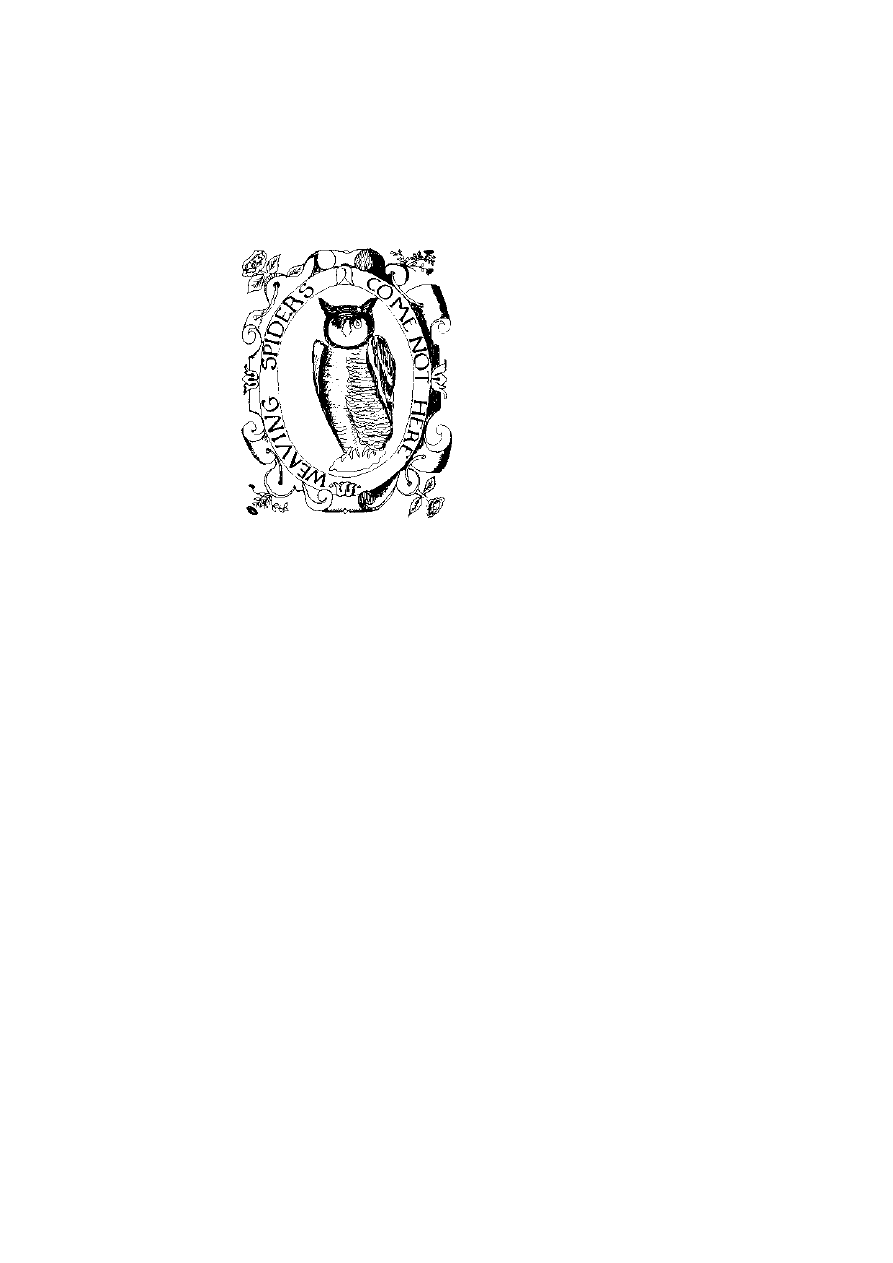
The Bohemian Grove
and Other Retreats
the text of this book is printed
on 100% recycled paper
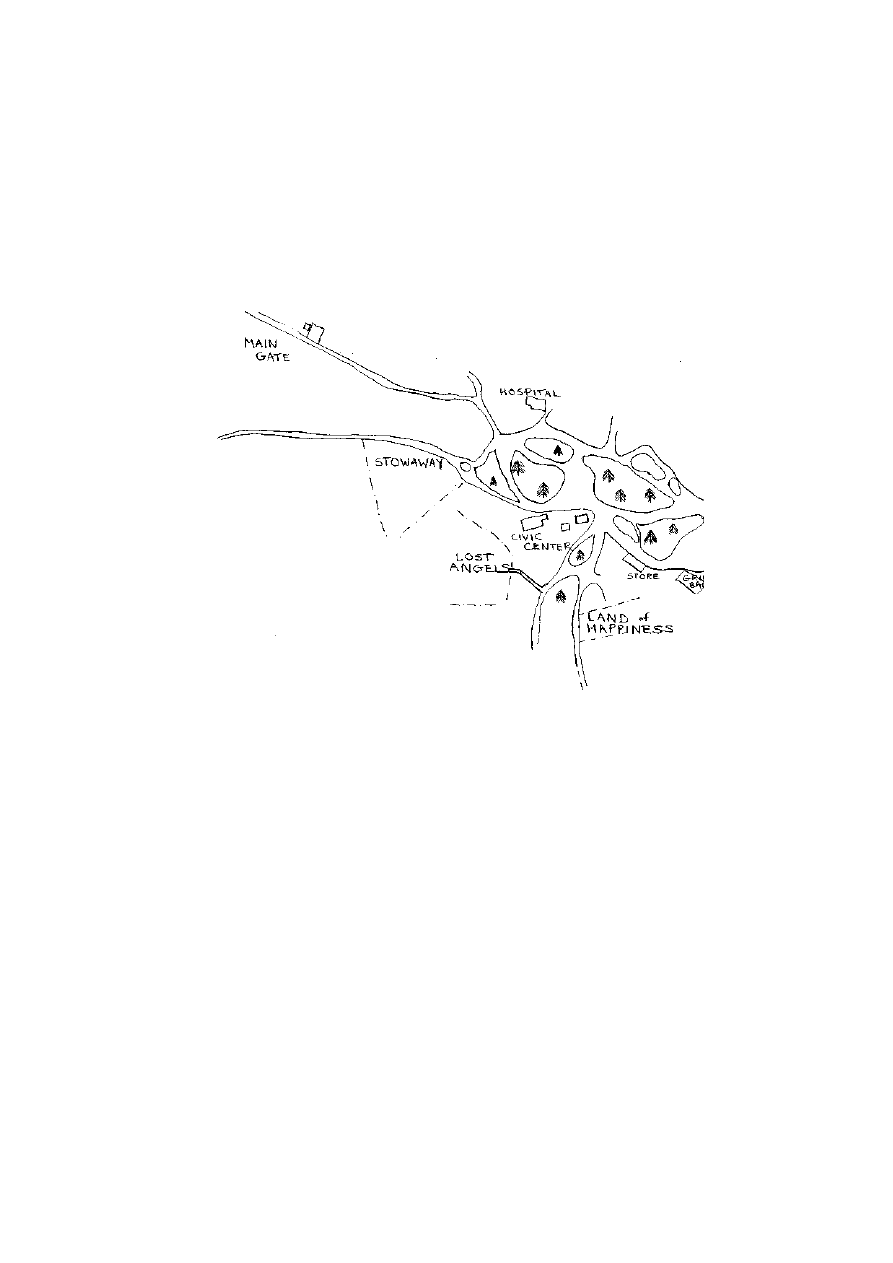
THE.
BOHEMIAN
GROVE
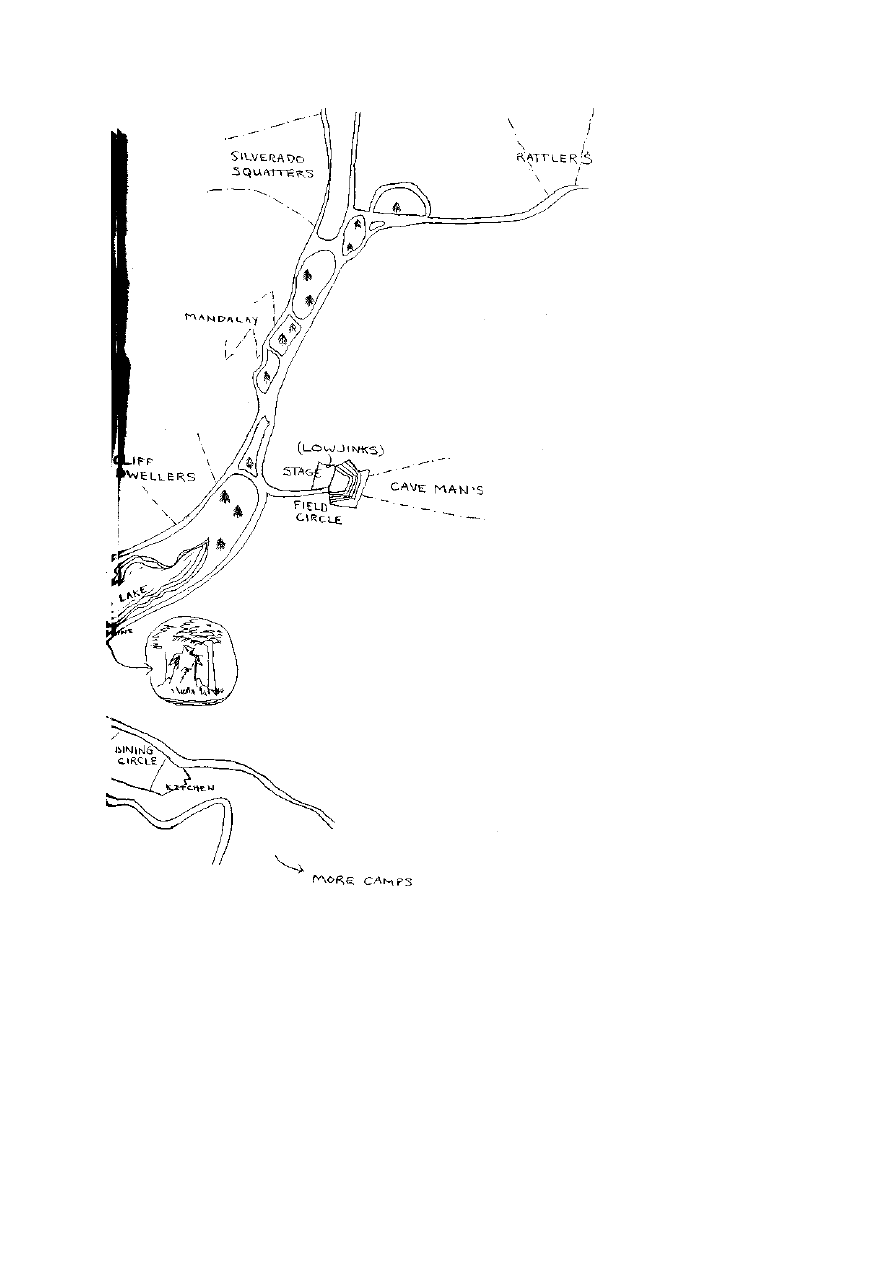

Books by G. William Domhoff
Fat Cats and Democrats (1972)
The Higher Circles (1970)
Who Ruks America? (1967)
C. Wright Mills and The Power Elite
(coeditor with Hoyt B. Ballard, 1968)

The Bohemian Grove
and Other Retreats
A Study in Ruling-Class Cohesiveness
by G. William Domhof f
HARPER TORCHBOOKS
Harper & Row, Publishers
New York, Hagerstown, San Francisco, London

To Lynne, Lori, Bill, and Joel
STANDAHD BOOK NUMBEH: 06-090395-3
THE BOHEMIAN GROVE AND OTHER RETREATS: A STUDY IN RULING-CLASS COHE-
srvENESS. Copyright © 1974 by G. William Domhoff. All rights reserved.
Printed in the United States of America. No part of this book may be used or
reproduced in any manner whatsoever without written permission except in
the case of brief quotations embodied in critical articles and reviews. For
information address Harper & Row, Publishers, Inc., 10 East 53rd Street, New
York, N.Y. 10022. Published simultaneously in Canada by Fitzhenry & Whiteside
Limited, Toronto.
Designed by Janice Stem
First
HARPER COLOPHON
edition 1975.
1 31 6 1
77 78 10 9 8 7 6 5 4

Contents
Preface
IX
1 The Bohemian Grove 1
2
Other Watering Holes
60
3 Do Bohemians, Rancheros, and Roundup
Riders Rule America?
82
Index
113
vii


Preface
In America, retreats are held by just about every group you
can think of—scouts, ministers, students, athletes, musicians,
and even cheerleaders. So it is not surprising that members of
the social upper class would also have clubs that sponsor such
occasions. Three of these retreats for the wealthy few are the
subject of this book.
Retreats are interesting in and of themselves. They are es-
pecially interesting when—like the bacchanalian rites discussed
in this book—they involve elaborate rituals, first-class entertain-
ment, a little illicit sex, and some of the richest and most power-
ful men in the country.
However, this book has a purpose beyond presenting a
relatively detailed description of three upper-class watering
holes that are of intrinsic interest. Upper-class retreats are also
of sociological relevance, for they increase the social cohesive-
ness of America's rulers and provide private settings in which
business and political problems can be discussed informally
and off the record. Moreover, their existence is evidence for a
theory heatedly disputed by most social scientists and political
commentators: that a cohesive ruling group persists in the
IX

United States despite the country's size and the diversity of
interests within it.
The material for this book was gathered from club members,
present and former employees of the clubs, historical archives,
and newspapers. Almost all the information presented can be
found in scattered public sources, but interviews were essential
in making sense out of it. Repeated discussions with two inter-
viewees also enriched the account with colorful details and
with a feel for the ethos of the encampments and rides. I am
deeply indebted to these people for their help.
The biographical information, which is the systematic core
of the book, comes primarily from the years 1965 to 1970.
Although post-1970 occupations and appointments are noted
for some of the people discussed, I have not tried to take ac-
count of deaths, retirements, and changes in occupational status
after 1970. For this reason, the account is already history in
some sense of the word. However, this presents no problem
from my perspective, for the people mentioned are merely
exemplars of an ongoing social process. I hope readers will
keep this caution in mind when they come across the name of
a deceased or retired person who is spoken of as if he were still
alive or active in his business or profession.
My primary research assistants for this project were Joel
Schaffer, Michael Spiro, and Lisa Young, who carried out the
studies of the social, economic, and political connections of
members and guests. They also combed newspaper and maga-
zine sources for relevant information. Their detailed labors are
gratefully acknowledged, and a special thanks is added to Lisa
Young for her fine drawings, which enhance this book.
I also want to express my thanks for the helpful hints of

writer John Van der Zee, whose research efforts on the first
retreat I discuss—the Bohemian Grove—came to my attention
as I was finishing my research and beginning to write. Although
we have not compared notes, he was helpful to me in several
ways, as I hope I was to him in certain small details. His book
on the Bohemian Grove is entitled Power at Ease: Inside the
Greatest Men's Party on Earth (Harcourt Brace Jovanovich,
1974).
My research on the second retreat discussed, the Rancheros
Visitadores, was aided in its initial stages by the work of
Michael Williams, "Los Rancheros Visitadores," a paper for
my graduate sociology seminar on the American upper class
at the University of California, Santa Barbara, in the fall of
1970. After the chapter was written, I learned further useful
details from the undergraduate research work conducted by
Peggy Rodgers and Donna Beck of the University of California,
Santa Barbara, and I am grateful to them for sharing their
findings with me.
As in the past, friends and colleagues have saved me from
a multitude of sins, both substantive and stylistic. In this in-
stance, my most helpful reader was my major informant, who
unfortunately must remain nameless. Other readers with help-
ful suggestions were Richie Zweigenhaft, a social psychologist
at the University of California, Santa Cruz, and Cynthia Mer-
man, my editor at Harper & Row.
My thanks, finally, to the Torchbook Department of Harper
& Row, and to the Research Committee of the Academic Sen-
ate, University of California, Santa Cruz, for the financial sup-
port that made this project possible, and to Mrs. Charlotte
Cassidy, Cowell College, University of California, Santa Cruz,
XI

for typing the final manuscript with her usual careful correction
of grammatical and spelling errors.
University of California
Santa Cruz, California
June 29,1973
G.W.D.
Xll

The Bohemian Grove
The Cremation of Care
Picture yourself comfortably seated in a beautiful open-air
dining hall in the midst of twenty-seven hundred acres of giant
California redwoods. It is early evening and the clear July air
is still pleasantly warm. Dusk has descended, you have finished
a sumptuous dinner, and you are sitting quietly with your
drink and your cigar, listening to nostalgic welcoming speeches
and enjoying the gentle light and the eerie shadows that are
cast by the two-stemmed gaslights flickering softly at each of
the several hundred outdoor banquet tables.
You are part of an assemblage that has been meeting in this
redwood grove sixty-five miles north of San Francisco for nearly
a hundred years. It is not just any assemblage, for you are a
captain of industry, a well-known television star, a banker, a
famous artist, or maybe a member of the President's Cabinet.
You are one of fifteen hundred men gathered together from all
over the country for the annual encampment of the rich and
the famous at the Bohemian Grove. And you are about to take
part in a strange ceremony that has marked every Bohemian
Grove gathering since 1880. You are about to be initiated into
the encampment by the Cremation of Care.

Out of the shadows on one of the hillsides near the dining
circle there come the low, sad sounds of a funeral dirge. As
you turn your head in its direction you faintly see the outlines
of men dressed in pointed red hoods and red flowing robes.
Some of the men are playing the funereal music; others are
carrying long torches whose flames are a spectacular sight
against the darkened forest.
As the procession approaches the dining circle, the dim
figures become more distinct, and attention fixes on several
men not previously noticed who are carrying a large wooden
box. Upon closer inspection the box turns out to be an open
coffin, and in that coffin is a body, a human body—real enough
to be lifelike at a glance, but only an imitation, made of black
muslin wrapped around a wooden skeleton. This is the body of
Care, symbolizing the concerns and woes that important men
supposedly must bear in their daily lives. It is Dull Care that is
to be cremated this first Saturday night of the two-week
encampment of the Bohemian Grove.
The cortege now trails slowly past the dining area, and the
men in the dining circle fall into line behind the hooded priests
and pallbearers, following the body of Care toward its ultimate
destination. The entire parade (all white, mostly elderly)
makes its way along a road leading to a picturesque little lake
that is yet another of the sylvan sights the Bohemian Grove
has to offer.
It takes the communicants about five minutes to make their
march to this new setting. Once at the lake the priests and the
body of Care go off to the right, in the direction of a very large
altar which faces the lake. The followers, talking quietly and
remarking on the once-again-perfect Grove weather, move to
the left so they can observe the ceremony from a green meadow

on the other side of the lake. They will be about fifty to a hun-
dred yards from the altar, which looms skyward thirty to forty
feet and reveals itself to be in the form of a huge Owl, whose
cement shell is mottled with primeval green mosses.
While the spectators seat themselves across the lake, the
priests and their entourage continue for another two or three
hundred yards beyond the altar to a boat landing. There the
bier is carefully transferred onto the Ferry of Care, which will
carry the body to the altar later in the ceremony. The ferry
loaded, the torches are extinguished and the music ends. The
attention of the spectators on the other side of the lake slowly
drifts back to the Owl shrine; it is illuminated by a gentle flame
from the Lamp of Fellowship which sits at its base.
People who have seen the ceremony before nudge you to
keep your eye on the large redwood next to the Owl. Moments
later an offstage chorus of "woodland voices" begins to sing.
Then a spotlight illuminates the tree you've been watching,
and there emerges from it a hamadryad, a "tree spirit," whose
life, according to Greek mythology, is intimately bound up
with the tree in which it lives. The hamadryad begins to sing,
telling the supplicants that beauty and strength and peace are
theirs as long as the trees of the Grove are there. It sings of
the "temple-aisles of the wood" that are made for "your de-
light," and implores the Bohemians to "burn away the sorrows
of yesterday" and to "cast your grief to the fires and be strong
with the holy trees and the spirit of the Grove."
1
With the end of this uplifting song, the hamadryad returns
to its tree, the chorus silences, and the light on the tree fades
1. Charles K. Field, The Cremation of Care (1946, 1953), for these
and following quotes. A copy of this small pamphlet can be found in
the Bancroft Library, University of California, Berkeley.

out. Only natural illumination from the moon and stars re-
mains, and it is time for the high priest and his many assistants
to enter the large area in front of the Owl. "The Owl is in his
leafy temple," intones the high priest. "Let all within the Grove
be reverent before him." He beseeches the spectators to be
inspired and awed by their surroundings, noting that this is
Bohemia's shrine. Then he invokes the motto of the club,
"Weaving spiders, come not here!"—which is a line from Shake-
speare's A Midsummer Night's Dream. It is supposed to warn
members not to discuss business and worldly concerns, but only
the arts, literature, and other pleasures, within the portals of
Bohemia.
The priest next walks down three large steps to the edge of
the lake. There he makes a flowery speech about the ripple of
waters, the song of birds, the forest floor, and evening's cool
kiss. Again he calls on the members to forsake their usual con-
cerns : "Shake off your sorrows with the City's dust and scatter
to the winds the cares of life." A second and third priest then
recall to memory deceased friends who loved the Bohemian
Grove, and the high priest makes yet another effusive speech,
the gist of it being that "Great Nature" is a "refuge for the
weary heart" and a "balm for breasts that have been bruised."
A brief song is sung by the chorus and suddenly the high
priest proclaims: "Our funeral pyre awaits the corpse of Care!"
A horn is sounded at the boat landing. Anon, the Ferry of
Care, with its beautifully ornamented frontispiece, begins its
brief passage to the foot of the shrine. Its trip is accompanied
by the music of a barcarole—a barcarole being the song of
Venetian gondoliers as they pole you through the canals of
Venice. As one listens to the barcarole, it becomes even clearer
that many little extra touches have been added by the Bohe-

mians who have lovingly developed this ritual over its ninety-
four-year history.
The bier arrives at the steps of the altar. The high priest
inveighs against Dull Care, the archenemy of Beauty. He
shouts, "Bring fire," and the torchbearers (eighteen strong)
enter. Then the acolytes quickly seize the coffin, lift it high
above their heads, and carry it triumphantly to the pyre in
front of the mighty Owl. It seems that Care is about to be
consumed by flames.
But not yet. Suddenly there is a great clap of thunder and a
rush of wind. Peals of loud, ugly laughter come ringing down
from a hill above the lake. A dead tree is illuminated in the
middle of the hillside, and Care himself bellows forth with a
thundering blast:
"Fools! Fools! Fools! When will ye learn that me ye cannot
slay? Year after year ye burn me in this Grove, lifting your
puny shouts of triumph to the stars. But when again ye turn
your feet toward the marketplace, am I not waiting for you,
as of old? Fools! Fools! To dream ye conquer Care!"
The high priest is taken aback by this impressive outburst,
but not completely humbled. He replies that it is not all a
dream, that he and his friends know they will have to face
Care when their holiday is over. They are happy that the good
fellowship created by the Bohemian Grove is able to banish
Care even for a short time. So the high priest tells Care, "We
shall burn thee once again this night and in the flames that eat
thine effigy we'll read the sign: Midsummer sets us free."
Dull Care, however, is having none of this. He tells the high
priest in no uncertain terms that priestly fires are not going to
do him in. "I spit upon your fire," he roars, and with that there
is a great explosion and all the torches are immediately extin-

guished. The only light remaining comes from the small flame
in the Lamp of Fellowship.
Things are clearly at an impasse. Care may win out after
all. There is only one thing to do: turn to the great Owl, the
totem animal of Bohemia, chosen as the group's symbol pri-
marily for its mortal wisdom—and only secondarily for its
discreet silence and its nightly prowling. The high priest falls
to his knees and lifts his arms toward the shrine. "O thou, great
symbol of all mortal wisdom," he cries. "Owl of Bohemia, we do
beseech thee, grant us thy counsel!"
The inspirational music of the "Fire Finale" now begins, and
an aura of light glows about the Owl's head. The Owl is going
to rise to the occasion! After a pause, the sagacious bird finally
speaks. No fire, he tells the assembled faithful, can drive out
Care if that fire comes from the mundane world, where it is
fed by the hates of men. There is only one fire that can over-
come the great enemy Care, and that, of course, is the flame
which burns in the Lamp of Fellowship on the Altar of
Bohemia. "Hail, Fellowship," he concludes, "and thou, Dull
Care, begone!"
With that, Care is on his way out. The light dies from the
dead tree. The high priest leaps to his feet and bounds up the
steps, snatches a burned-out torch from one of the bearers, and
relights it from the flame of the Lamp of Fellowship. Just as
quickly he ignites the funeral pyre and triumphantly hurls the
torch into the blaze.
The orchestral music in the background intensifies as the
flames leap higher and higher. The chorus sings loudly about
Dull Care, archenemy of Beauty, calling on the winds to make
merry with his dust. "Hail, Fellowship," they sing, echoing the
Owl. "Begone, Dull Care! Midsummer sets us free!" The wail-

ing voice of Care gives its last gasps, the music gets even
louder, and fireworks light the sky and fill the Grove with the
reverberations of great explosions. The band, appropriately
enough, strikes up "There'll Be a Hot Time in the Old Town
Tonight." Care has been banished, but only with a cast of 250
elders, priests, torchbearers, shore patrols, fire tenders, produc-
tion managers, and woodland voices.
As this climax approaches, some fifty minutes after the march
began, the quiet onlookers on the other side of the lake begin to
come alive. After all, it is a night for rejoicing. The men begin
to shout, to sing, to hug each other, and dance around. They
have been freed by their priests and their Owl for some good
old-fashioned hell raising. They couldn't be happier if they were
hack in college and their fraternity had won an intramural
football championship.
Now the ceremony is over. The revelers, initiated into the
carefree attitude of the Bohemian Grove, break up into small
groups as they return to the camps that crowd next to each
other in the central area of the Grove. It will be a night of story-
telling and drinking for the men of Bohemia as they sit about
their campfires or wander from camp to camp, renewing old
friendships and making new ones. They will be far away from
their responsibilities as the decision makers and opinion mold-
ers of corporate America.
Jinks High and Jinks Low
The Cremation of Care is the most spectacular event of the
midsummer retreat that members and guests of San Francisco's
Bohemian Club have taken every year since 1878. However,
there are several other entertainments in store. Before the

Bohemians return to the everyday world, they will be treated to
plays, variety shows, song fests, shooting contests, art exhibits,
swimming, boating, and nature rides. Of all these delights, the
most elaborate are the two Jinks: High Jinks and Low Jinks.
Among Bohemians, planned entertainment of any real mag-
nitude is called a Jinks. This nomenclature extends from the
earliest days of the club, when its members were searching for
precedents and traditions to adopt from the literature and en-
tertainment of other times and other places. In the case of
Jinks, they had found a Scottish word which denotes, generally
speaking, a frolic, although it also was used in the past to refer
to a drinking bout which involved a matching of wits to see
who paid for the drinks. Bohemian Club historiographers, how-
ever, claim the word was gleaned from a more respectable
source, Guy Mannering, a novel by Sir Walter Scott; there the
High Jinks are a more elevated occasion, with drinking only a
subsidiary indulgence.
2
In any event, the early Jinks at the Grove slowly developed
into more and more elaborate entertainments. By 1902 the High
Jinks had become what it is today, a grandiose, operetta-like
extravaganza that is written and produced by club members
for its one-time-only presentation in the Grove. The High Jinks,
presented on the Friday night of the last weekend, is consid-
ered the most important formal event of the encampment.
Most of the plays written for the High Jinks have a mythical
or fantasy theme, although a significant minority have a his-
torical setting. Any moral messages center on inevitable human
frailty, not social injustice. There is no spoofing of the powers-
that-be at a High Jinks; it is strictly a highbrow occasion. A
2. Robert H. Fletcher, The Annals of the Bohemian Club (San Fran-
cisco: Hicks-Judd Company, 1900), Vol. I, 1872-80, p. 34.
8

few titles give the flavor: The Man in the Forest (1902), The
Cave Man (1910), The Fall of Ug (1913), The Rout of the
I'hilistines (1922), The Golden Feather (1939), Johnny Apple-
seed (1946), A Gest of Robin Hood (1954), Rip Van Winkle
(1960), and The Bonnie Cravat (1970).
A priest, of all unlikely people, holds the honor of being the
only person to be the subject of two Grove plays. He is the
Patron Saint of Bohemia, Saint John of Nepomuck (pronounced
NAY-po-muk), a man who lived in the thirteenth century in
the real Bohemia that is now part of Czechoslovakia. Saint
John received his unique distinction among latter-day Bohe-
mians in 1882, when his sad but courageous story was told in a
jinks "sired" (the club argot for master of ceremonies) by the
poet Charles Warren Stoddard.
Saint John was a cutup in his youth, but had forsaken
ephemeral pleasures—or at least most of them—for the priest-
hood. One of his first assignments was as a tutor to the heir
apparent to the kingship of Bohemia. John soon became fast
friends with the fun-loving prince, often joining him in his
spirited and amorous adventures. When the prince became
king, he made Saint John the court confessor.
All went well for Saint John until the king began to suspect
that his beautiful queen was having a love affair with the
Margrave of Moravia. To allay his suspicions, the king naturally
turned to his loyal friend and teacher, Saint John of Nepomuck,
demanding that this former companion in many revelries reveal
to him the most intimate confessions of the queen. Saint John
refused. The king pleaded, but to no avail. Then the king
threatened; this had no effect either. Finally, in a fit of rage,
he ordered Saint John hurled into the river to drown. John
chose to die rather than reveal a woman's secrets. Here, truly,

was a remarkable fellow, and his story appealed mightily to the
San Francisco Bohemians of the nineteenth century.
Several months after the poet Stoddard introduced Saint
John to his fellow Bohemians there arrived at the clubhouse
in San Francisco a small statue of Saint John from faraway
Czechoslovakia. It seems one of the people present for Stod-
dard's talk had been Count Joseph Oswald Von Thun of
Czechoslovakia, who had been much taken by the club and
its appreciation of his fellow countryman. Upon his return to
Czechoslovakia he had commissioned a woodcarver to make
a replica of the statue of Saint John which adorns the bridge
in Prague near the place of his drowning.
This unexpected gift still guards the library room in the
Bohemians' large club building in San Francisco—except during
the encampment at the Grove, that is. For that event the statue
is carefully transported to a hallowed tree near the center of
the Grove, where Saint John, with his forefinger carefully
sealing his lips, can be a saintly reminder of the need for discre-
tion.
The legend surrounding Saint John of Nepomuck became
part of the oral tradition of the Bohemian Club. New members
inevitably hear the story when they happen upon the statue
while being shown around the city clubhouse or the Grove.
But oral tradition is not enough for a patron saint, and the good
man's legend was therefore enacted in a Grove play in 1921
under the title St. John of Nepomuck. It was retold in 1969 by
a different author under the title St. John of Bohemia.
How good are the Grove plays? "Pretty darn good," says one
member who knows theater. He thinks maybe one in ten High
Jinks would be a commercial success if produced for outside
audiences. Another member is not so sure about their general
10

appeal. "They're damned fine productions," he claims, "but
they are so geared to the special features of a Grove encamp-
ment, and so full of schmaltz and nostalgia, that it's hard to
say how well they'd go over with ordinary audiences."
Whatever the quality, the plays are enormously elaborate
productions, with huge casts, large stage sets, much singing,
and dazzling lighting effects. "Hell, most stages wouldn't hold
a Grove production," said our second informant. "That Grove
stage is about ten thousand square feet, and there are all sorts
of pathways leading into it from the hillside behind it. Not to
mention the little clearings on the hillside which are used to
great effect in some plays."
A cast for a typical Grove play easily runs to seventy-five or
one hundred people. Add in the orchestra, the stagehands, the
carpenters who make the sets, and other supporting personnel,
and over three hundred people are involved in creating the
High Jinks each year. Preparations begin a year in advance,
with rehearsals occurring two or three times a week in the
month before the encampment, and nightly in the week before
the play.
Costs are on the order of $20,000 to $30,000 per High Jinks,
a large amount of money for a one-night production which does
not have to pay a penny for salaries (the highest cost in any
commercial production). "And the costs are talked about, too,"
reports my second informant. " 'Hey, did you hear the High
Jinks will cost $25,000 this year?' one of them will say to
another. The expense of the play is one way they can relate
to its worth."
One person clearly impressed by a Grove play and its costs
was Harold L. Ickes, the outspoken Secretary of the Interior
during the New Deal era. Unbeknown to most people at the
11

time, Ickes was keeping a detailed diary of
The Secret Diary of Harold L. Ickes appeared in
contained, among other interesting observations
Bohemian Grove, the following account of the play for 1934:
But the thing that made the greatest impression
the play that night. The theater is an open-air on
opening, surrounded by towering sequoias. The stage
foot of a sharp hill. The hill is covered with
growth and the proscenium arch of the stage
giant sequoias with intermingled tops. It was one
impressive and magnificent settings I have ever
that night was a serious one, the theme bein
of the old Irish Druids by St. Patrick. It had
the late Professor James Stephens, an Englishm
been a member of the English faculty at t
California. All the parts were taken by the
Bohemian Club and the acting could not have
it had been done by professionals; in fact, I
would have been so well done. It was
very
the actors carrying torches and following the
hillside. The costuming and the lighting were
I was told that the lighting for that one play
certainly it would have been difficult to improve upon it.
3
The High Jinks is the pride of the Grove, but
brow stuff goes a long way among clubmen,
who like to think of themselves as cultured.
beginnings of the club, the High Jinks has been counterbal-
3. Harold L. Ickes, The Secret Diary of Harold L. I
First Thousand Days, 1933-36. (New York: Simon and
pp. 178-79. I am grateful to my friend and colleagu
W. Baer, for calling this passage to my attention.
12

anced by the more slapstick and ribald fun of Low Jinks. For
many years the Low Jinks were basically haphazard and extem-
poraneous, but slowly they too became more elaborate and
professional as the Grove grew from a few campers on a week-
end holiday to a full-blown two-week encampment which re-
quires year-round planning and maintenance. Now the Low
Jinks is a specially-written musical comedy requiring almost
as much attention and concern as the High Jinks. Personnel
requirements are slightly less—perhaps 200-250 people to the
300-350 needed for High Jinks. Costs also are slightly lower—
$5,000 to $10,000 per year versus $20,000 or more for a High
Jinks.
The subject matter of the Low Jinks is very different from
that of the High Jinks. The title of the first formal Low Jinks
in 1924 was The Lady of Monte Rio, which every good Bohe-
mian would immediately recognize as an allusion to the ladies
of the evening who are available in certain inns and motels
near the Grove. The 1968 Low Jinks concerned The Sin of
Ophelia Grabb, who lived with Letchwell Lear in unwedded
bliss even though she was the daughter of the mayor of Shady
Corners. Thrice Knightly, another recent Low Jinks, also needs
no explanation, especially to old fraternity boys who know that
"once a king always a king, but once a knight is enough." And
Socially Prominent, the 1971 Low Jinks, was unsparingly funny
about the High Society whence many members originate.
Little Friday Night, Big Saturday Night
The Cremation of Care, the High Jinks, and the Low Jinks
are productions involving hundreds of ordinary Bohemian Club
members. They require planning, coordination, and money,
13

and Bohemians are proud of the fact that they are part of a
club which creates its own theatrical enjoyments. However,
the Bohemians are not averse to enjoying professional enter-
tainment by stars of stage, screen, and television. For this, there
are the Little Friday Night and the Big Saturday Night.
The Little Friday Night is held on the second weekend of
the encampment. The Big Saturday Night is on the third week-
end—it closes the encampment. Both are shows made up of acts
put on by famous stars. It is here that members may hear jokes
that fellow Bohemians Art Linkletter, Edgar Bergen, and Dan
Rowan never tell on television, or enjoy songs that Phil Harris
doesn't do in the nightclubs of Lake Tahoe and Reno. The host
for the evening may be Ray Bolger, one of the most active
entertainers in Bohemia, or Andy Devine, Ralph Edwards, or
Lowell Thomas. One of the vocalists might be Bing Crosby,
another, Dennis Day. For musical numbers there is Les Brown
—or perhaps Raymond Hackett or George Shearing. Celebrity
members are supplemented by celebrity guests. Milton Berle
entertained one year. Jerry Van Dyke was part of the Big
Saturday Night in 1970. Victor Borge was a recent guest. So
were trumpeters Al Hirt and Harry James.
All of this talent is free, of course. No one would think of
asking for money to perform for such a select audience, and
if anyone should think to ask, he immediately would be disin-
vited. People are supposed to understand it is an honor to enter-
tain those in attendance at the Bohemian Grove.
Lakeside Talks
Entertainment is not the only activity at the Bohemian
Grove. For a little change of pace, there is intellectual stimula-
14

tion and political enlightenment every day at 12:30
P
.
M
.
Since
1932 the meadow from which people view the Cremation of
Care also has been the setting for informal talks and briefings
by people as varied as Dwight David Eisenhower (before he
was President), Herman Wouk (author of The Caine Mutiny),
Bobby Kennedy (while he was Attorney General), and Neil
Armstrong (after he returned from the moon).
Cabinet officers, politicians, generals, and governmental ad-
visers are the rule rather than the exception for Lakeside Talks,
especially on weekends. Equally prominent figures from the
worlds of art, literature, and science are more likely to make
their appearance during the weekdays of the encampment,
when Grove attendance may drop to four or five hundred
(many of the members only come up for one week or for the
weekends because they cannot stay away from their corpora-
tions and law firms for the full two weeks).
Members vary as to how interesting and informative they
find the Lakeside Talks. Some find them useful, others do not,
probably depending on their degree of familiarity with the
topic being discussed. It is fairly certain that no inside or secret
information is divulged, but a good feel for how a particular
problem will be handled is likely to be communicated. What-
ever the value of the talks, most members think there is some-
thing very nice about hearing official government policy, ortho-
dox big-business ideology, and new scientific information from
a fellow Bohemian or one of his guests in an informal atmos-
phere where no reporters are allowed to be present.
One person who seems to find Lakeside Talks a useful forum
is President Richard M. Nixon, a Bohemian Club member since
1953. A speech he gave at the Grove in 1967 was the basis for
a public speech he gave a few months later. Richard J. Whalen,
15

one of Nixon's speech writers in the late sixties, tells the story as
follows:
He would speak at the Hoover Institution, before a confer-
ence on the fiftieth anniversary of the Bolshevik revolution.
"I don't want it to be the typical anti-Communist harangue—
you know, there's Nixon again. Try to lift it. I want to take a
sophisticated hard line. I'd like to be very fair and objective
about their achievements—in fifty years they've come from a
cellar conspiracy to control of half the world. But I also want
to underline the horrible costs of their methods and system."
He handed me a copy of his speech the previous summer at
Bohemian Grove, telling me to take it as a model for outlining
the changes in the Communist world and the changing U.S.
Policy toward the Soviet Union.*
The ease with which the Bohemian Grove is able to attract
famous speakers for no remuneration other than the amenities
of the encampment attests to the high esteem in which the
club is held in the higher circles. Down through the years the
Lakeside podium has hosted such luminaries as Lee DuBridge
(science), David Sarnoff (business), Wernher von Braun
(space technology), Senator Robert Taft, Lucius Clay (military
and business), Earl Warren (Supreme Court), former Califor-
nia Republican Governor Goodwin J. Knight, and former Cali-
fornia Democratic Governor Pat Brown. For many years former
4. Richard J. Whalen, Catch the Falling Flag: A Republican's Chal-
lenge to His Party (Boston: Houghton Mifflin, 1972), p. 25. Earlier in
this book, on page 4, Whalen reports that his own speech in 1969 at the
Bohemian Grove, which concerned the U.S.-Soviet nuclear balance, was
distributed by President Nixon to cabinet members and other administra-
tion officials with a presidential memorandum commending it as an "excel-
lent analysis." I am grateful to sociologist Richard Hamilton of McGill
University for bringing this material to my attention.
16

President Herbert C. Hoover, who joined the club in 1913, was
a regular feature of the Lakeside Talks, with the final Saturday
afternoon being reserved for his anachronistic counsel.
Politicians apparently find the Lakeside Talks especially at-
tractive. "Giving a Lakeside" provides them with a means for
personal exposure without officially violating the injunction
"Weaving spiders, come not here." After all, Bohemians ra-
tionalize, a Lakeside Talk is merely an informal chat by a friend
of the family.
Some members, at least, know better. They realize that the
Grove is an ideal off-the-record atmosphere for sizing up politi-
cians. "Well, of course when a politician comes here, we all get
to see him, and his stock in trade is his personality and his
ideas," a prominent Bohemian told a New York Times reporter
who was trying to cover Nelson Rockefeller's 1963 visit to the
Grove for a Lakeside Talk. The journalist went on to note that
the midsummer encampments "have long been a major show-
case where leaders of business, industry, education, the arts,
and politics can come to examine each other."
5
Speakers for the 1970 encampment were an exceptionally
impressive group. Indeed, the program was so heavily laced
with governmental appointees that protests were voiced by
some members. Following is the main portion of it for that year
in the order it appears in the club's yearly Report of the Presi-
dent and the Treasurer.
5. Wallace Turner, "Rockefeller Faces Scrutiny of Top Califomians:
Governor to Spend Weekend at Bohemian Grove among State's Establish-
ment" (New York Times, July 26, 1963), p. 30. In 1964 Senator Barry
Goldwater appeared at the Grove as a guest of retired General Albert C.
Wedemeyer and Herbert Hoover, Jr. For that story see Wallace Turner,
"Goldwater Spending Weekend in Camp at Bohemian Grove" (New
York Times, July 31, 1964), p. 10.
17

Hardin B. Jones
Professor of Medical Physics and Physiology,
University of California, Berkeley
Rudolph A. Peterson
President of the Bank of America
Norman H. Strouse
Renowned book collector, retired
President of J. Walter Thompson
advertising agency.
Robley C. Williams
Professor of Biophysics, University of
California, Berkeley
Frank
Shakesp
eare
Director, United States Information Agency
Ernest L. Wilkinson
President, Brigham Young University
Henry Kissinger
President Nixon's foreign policy adviser
Melvin Laird
Secretary of Defense
Edward Cole
President of General Motors
Earl C. Bolton
Vice President, University of California, Berkeley
Gunnar Johansen
Professor of Music, University of Wisconsin
Russell E. Train
Chairman, Council on Environment Quality
Emil Mosbacher
Chief of Protocol, State Department
William P. Rogers
Secretary of State
Neil Armstrong
Astronaut
18

For 1971, President Nixon was to be the featured Lakeside
speaker. However, when newspaper reporters learned that the
President planned to disappear into a redwood grove for an
off-the-record speech to some of the most powerful men in
America, they objected loudly and vowed to make every effort
to cover the event. The flap caused the club considerable em-
barrassment, and after much hemming and hawing back and
forth, the club leaders asked the President to cancel his sched-
uled appearance. A White House press secretary then an-
nounced that the President had decided not to appear at the
Grove rather than risk the tradition that speeches there are
strictly off the public record.
6
However, the President was not left without a final word to
his fellow Bohemians. In a telegram to the president of the
club, which now hangs at the entrance to the reading room
in the San Francisco clubhouse, he expressed his regrets at
not being able to attend. He asked the club president to con-
tinue to lead people into the woods, adding that he in turn
would redouble his efforts to lead people out of the woods. He
also noted that, while anyone could aspire to be President of
the United States, only a few could aspire to be president of
the Bohemian Club.
Cliff Dwellers, Moonshiners, and Silverado Squatters
Not all the entertainment at the Bohemian Grove takes place
under the auspices of the committee in charge of special events.
The Bohemians and their guests are divided into camps which
•_; 6. James M. Naughton, "Nixon Drops Plan for Coast Speech" (New
York Times, July 31, 1971), p. 11.
19

evolved slowly over the years as the number of people on the
retreat grew into the hundreds and then the thousands. These
camps have become a significant center of enjoyment during
the encampment.
At first the camps were merely a place in the woods where
a half-dozen to a dozen friends would pitch their tents. Soon
they added little amenities like their own special stove or a
small permanent structure. Then there developed little camp
"traditions" and endearing camp names like Cliff Dwellers,
Moonshiners, Silverado Squatters, Woof, Zaca, Toyland, Sun-
dodgers, and Land of Happiness. The next steps were special
emblems, a handsome little lodge or specially constructed
tepees, a permanent bar, and maybe a grand piano.
7
Today
there are 129 camps of varying sizes, structures, and statuses.
Most have between 10 and 30 members, but there are one or
two with about 125 members and several with less than 10. A
majority of the camps are strewn along what is called the River
Road, but some are huddled in other areas within five or ten
minutes of the center of the Grove.
The entertainment at the camps is mostly informal and
impromptu. Someone will decide to bring together all the jazz
musicians in the Grove for a special session. Or maybe all the
artists or writers will be invited to a luncheon or a dinner at a
camp. Many camps have their own amateur piano players and
informal musical and singing groups which perform for the
rest of the members.
But the joys of the camps are not primarily in watching or
7. There is a special moisture-proof building at the Grove to hold the
dozens of expensive Steinway pianos belonging to the club and various
camps.
20

listening to performances. Other pleasures are create
them. Some camps become known for their
specialties, such as a particular drink or a particular
Jungle Camp features mint juleps, Halcyon has a
high martini maker constructed out of chemical glas
the Owl's Nest it's the gin-fizz breakfast—about a
people are invited over one morning during the
for eggs Benedict, gin fizzes, and all the trimmings.
Poison Oak is famous for its Bulls' Balls Lunch.
a cattle baron from central California brings a large
testicles from his newly castrated herds for the del
Poison Oakers and their guests. No one goes aw
Bulls' balls are said to be quite a treat. Meanwhile,
camp has a somewhat different specialty, which is
sarily known to members of every camp. It houses
pornographic collection which is more amusing tha
Connoisseurs do not consider it a great show, but it is
way to kill a lazy afternoon.
Almost all camps stress that people from other camps
to walk in at any time of the day or night. Hospitali
free drink are the proper form of behavior, and eve
about this easy congeniality. Some camps go out of
to advertise their friendliness. In the little Grove
featuring birds and mammals from the area, the Ratt
put the following sign above the rattlesnake exhibit
looking at this rattlesnake is hereby entitled to a free
Rattler's Camp."
A Brief history of all the camps is included in
scrapbooks in the Bohemian Club library room. Most
histories describe how the camp acquired its name, tell
dote or two about the camp or its founders, and then list some
21

of the famous Americans who have been guests there over the
generations.
A few camps go so far as to print for the members a history
of the camp. The Lost Angels, a camp with a strong Los An-
geles contingent, permitted themselves this little indulgence
on their fiftieth anniversary in 1958. The history, complete
with pictures and membership lists, tells how the founders of
the camp broke away from another camp because they felt
"lost," only to find themselves half-seriously hassled by the
Grove authorities for a campfire that was smoking out fellow
Bohemians. The Lost Angels retaliated for this harassment by
moving to a somewhat removed hillside, where the next year
they built an utterly lavish (by Grove standards) lodge com-
plete with elegant mahogany furniture and special appoint-
ments like virgin lambs' wool blankets from the Isle of Wight
and lace tablecloths from Ireland. It was a $12,000 joke even
in 1908-which is about $50,000 by 1958 standards.
The outlandish Lost Angels camp was a huge success in
outraging members of other camps. It caused consternation
everywhere, inspiring numerous jokes and jingles which are
faithfully preserved in Lost Angels lore. However, the final
laugh was on the Lost Angels. When they weren't looking,
members of other camps stole everything of value. Lost Angels
was happy to return to the plainer and simpler atmosphere
that the Grove tries to maintain, but it is still regarded as one
of the nicest camps in the Grove.
The camps, then, add another dimension to the activities at
the Bohemian Grove. They provide a basis for smaller and
less-organized entertainments in an even more intimate atmos-
phere. They provide an excuse for half-serious rivalries, for
practical jokes, for within-group differentiation. "The camps,"
22

one former employee told me, "make the Bohemian Grove seem
like a college fraternity system transplanted from the campus
to the redwoods." "Like an overgrown boy-scout camp," ex-
plained another employee, who drives one of the little tram
buses that travel quietly throughout the Grove for the conven-
ience of those who don't wish to walk.
Other Delights
Formal Grove shows and informal camp shenanigans do not
exhaust the possibilities of the Bohemian Grove. Members can
find a number of other ways to amuse themselves.
Some wander about quietly, drink in hand, enjoying the red-
wood trails. Others walk down the River Road to look at the
meandering water of the Russian River 150 feet below; often
they take the winding path down to the river and its beach,
where they sit on the large beach deck, wade in the shallow
water along the banks, swim in the specially developed swim-
ming hole, or even paddle out in one of the Grove canoes.
Others can be found taking part in the skeet shooting and
trap shooting that are provided. Some take regularly scheduled
"rim rides" on Grove buses, journeying to the more distant
parts of the Grove's several thousand acres while a tour guide
recounts the natural history of the area. Many plan their late-
morning visit to the Civic Center (a group of small buildings
which serve as message center, barber shop, and drug store)
so they can make it to the noon organ concert which is held
each day by the lake. (The Bohemian band and the Bohemian
orchestra also perform one afternoon concert each during the
encampment.)
A pleasant afternoon can be spent at the Ice House, the
beautiful redwood building that houses an annual art exhibit
23

made up of paintings, photographs, and sculpture created by
Bohemian Club members. Over three hundred original works
of art are usually available for viewing.
8
For evenings without
large productions, there are less formal Campfire Circle enter-
tainments featuring the band, the orchestra, the chorus, or
individual storytellers and entertainers.
Skeet shooting, swimming, art exhibitions—there is plenty to
see and do in the Bohemian Grove even when a big production
is not being staged. It is truly a place of many delights. But,
despite all these attractions, it remains most of all a place to
rest and relax in the company of friends.
Jumping the River
Alert readers may have noticed that one pleasure is missing
for these hundreds of men in search of a good time. That
pleasure is female companionship. For a certain minority of
Bohemians—reliable estimates put the figure well below 10
percent—such companionship is a necessity of life they cannot
be without. Since women are strictly forbidden to enter the
Grove, there is only one thing to do—jump the river.
Now, eager Bohemians do not literally jump or swim across
the river. That is only an expression which some Bohemians
use for going to one of two nearby towns to find an attractive
prostitute at a bar which caters to the Bohemian Grove trade.
There are two little towns near the Grove. One, Monte Rio,
is about a mile from the Grove entrance, and has a population
of 997. The other, Guerneville, a metropolis of 1,005, is a: mile
or two from Monte Rio; it has seven or eight bars. In the not
8. And for sale. Painters in particular earn a considerable amount of
money through the Bohemian Club. But that is getting ahead of the story.
24

too distant past there were several bars in both towns which
were frequented by Bohemians who had jumped the river.
Two or three even had private rooms where people could have
their own special parties. But bars come and go, and the scene
of the action changes from time to time. In recent years much
of the extracurricular activity centered around the Gas House
Tavern in Guerneville, where the owner was partial to the
Grove to the point of putting Grove scenes on his walls and
trying to accumulate Bohemian mementos.
Jumping the river suddenly became a risky sport in 1971.
A new sheriff, making good on a clean-government campaign
promise, began to crack down on prostitutes. He even hired an
undercover agent to help him gain information. The sheriff
and his investigators claim to have observed about twenty
women turning, on the average, three tricks a night. Contacts,
they said, were made in the Gas House Tavern, and the ar-
rangement was consummated in one of the nearby motels or
cottages. Some prominent business people, but no politicians,
are mentioned in their reports.
The result of these snoopings was the indictment of the Gas
House owner for allowing females to solicit acts of prostitution
in his place of business. Also indicted were a married couple
from San Francisco, who were charged with supplying the
prostitutes at a reported fee of $100 to $150 per person. It
looked like the county had a very good case, but it went out
the window on the first day of the trial when the defense law-
yers revealed that the prosecution's star witness, the under-
cover agent, was herself a former prostitute with an arrest
record.
The angry judge immediately declared a mistrial. "I feel that
frankly it is incredible that four investigative agencies, the
25

Sheriffs Office, the District Attorney's investigators, the Attor-
ney General's investigators for the state, and the FBI were
unable to locate [a record of] a felony conviction of one of
their witnesses," he scolded.
9
The thirty-nine-year-old former
prostitute had been suggested to Sonoma County authorities
for the undercover role by an FBI agent. When called to the
stand, the Sonoma County criminal investigator who hired her
said that the FBI man warned him she had been a registered
prostitute in Nevada in 1954, but not that she had been con-
victed of pimping and pandering in California in 1961. Asked
why he didn't check further, he replied that he didn't feel the
need because prostitution is not illegal in Nevada. A blunder
thus spared the Bohemian Grove from having further details of
Guerneville prostitution entered into the court records and
the newspapers.
River jumping decreased considerably during the 1972 en-
campment, if we can trust San Francisco Chronicle columnist
Herb Caen, a man who seems to have excellent sources about
the goings-on of San Franciscans. "Fewer prostitutes around
the Bohemian Grove than last year," he reported. "The red-
lighters no longer have the green light after that recent well-
publicized trial."
10
Others suspect that the prostitutes keep
closer to their motels, with addresses being supplied by knowl-
edgeable bartenders.
Decrease or not, the amount of prostitution around the
encampment was always greatly overplayed. As so often in
groups of men, with their proclivities toward bragging and
9. Paul Avery, "Mistrial Ordered in Russian River Case" (San Fran-
cisco Chronicle, March 15, 1972), p. 3.
10. Herb Caen, "The Morning Line" (San Francisco Chronicle, July
25, 1972), p. 17.
26

storytelling, there is more talk than action. Indeed, many people
who know only a little about the Grove seem to think it is one
big orgy. Members of the Bohemian Club are extremely shy
of publicity, and they are especially sensitive on the subject
of prostitution around the Grove. They do not like to have the
subject raised at all, and when it is discussed, they have every
reason to underestimate greatly its prevalence. Nevertheless,
their estimates are not much lower than those of more reliable
sources—a friend who worked in the Grove parking lot one
summer on the midnight to 8
A
.
M
.
shift; a former employee
inside the camp; and a member who spent many a late night
around the Grove entrance.
However, it is not merely outsiders and journalists who talk
about prostitution around the Bohemian Grove. The subject
also commands bemused attention within the encampment
itself. The relatively few incidents are the subject of exaggera-
tion, myth making, and a lot of kidding. The topic is outranked
as a subject for light conversation only by remarks about drink-
ing enormous quantities of alcohol and urinating on redwoods.
Even a sedate member far removed from high living could
recall a story about a foursome chipping in to hire a prostitute
for one of their friends on his seventieth birthday. Such a tale
may or may not be true, but it is typical of the kind of story
that goes around in an idyllic Grove which only lacks for mem-
bers of the opposite sex.
The Sociology of Bohemia
Beyond noting that Bohemians and their guests are likely to
be rich, famous, or politically prominent, the account thus far
has provided little systematic indication of their socioeconomic
27

characteristics. It is therefore time to go into more detail about
the social, economic, and political connections of the men who
come to the Bohemian Grove for a little rest and recreation. A
careful study of the 1968 membership list and the 1970 guest
list—the only recent lists available to me—reveals the following
information.
Geographic Distribution.
Men come to the Bohemian Grove from every part of the
United States. Forty states and the District of Columbia con-
tributed members and guests. California, as might be expected,
supplies a big majority of the campers. New York is second
with 133 representatives, followed by Washington (42), Illi-
nois (38), Ohio (28), District of Columbia (27), Hawaii (24),
and Texas (20). The areas least represented are the Deep
South (South Carolina, Georgia, Alabama, Louisiana, Missis-
sippi, and Arkansas) with 5, and the thinly populated states of
the Far West (Montana, Utah, Wyoming, and Idaho) with 7.
Social Standing
There are relatively reliable ways of determining whether
or not a person is a member of the social upper class in Amer-
ica. They include a listing in certain social registers and blue
books, attendance at one of a few dozen expensive private
schools, and membership in one of several dozen exclusive
social clubs. I say these means are "relatively reliable" because
no social indicators in any aspect of the social sciences are
likely to be perfect.
On the one hand, there are going to be mistakes where people
identified as members of the upper class by one or another
28

indicator are not in fact members. Such mistakes ("false posi-
tives") can occur for a number of reasons. Perhaps the person
was among the few who went to a private school on a scholar-
ship. Then too, upper-middle-class sons and daughters of pro-
fessionals and academics often attend such schools. In the case
of the clubs, there is reason to believe they sometimes include
people of middle-class backgrounds who have achieved high
positions in certain occupations.
Conversely, there will be mistakes where members of the
upper class are overlooked ("false negatives")—because there
is no social register or blue book for their city, because not all
members of the upper class bother to list themselves in avail-
able blue books, because they do not admit to their private-
school background in biographical sources, or because they do
not find pleasure in belonging to clubs. The "false positives"
and the "false negatives," then, are likely to cancel each other
out.
Perhaps the biggest problem in determining upper-class
standing is that the necessary kinds of information are not
publicly available on many people. Since prep-school alumni
lists and social-club membership lists are hard to obtain, there
is no easy way of finding out about the social backgrounds
of the many people who are not outstanding enough in their
occupations to be listed in one of several Who's Who volumes.
Thus, social indicators give us only an idea of the degree to
which members of the upper class are overrepresented in vari-
ous social groups, corporations, and governmental agencies.
11
11. For further discussion of these problems, and a list of social indi-
cators, see G. William Domhoff, Who Rules America? (Englewood Cliffs,
N.J.: Prentice-Hall, 1967), Chapter 1, and G. William Domhoff, The
Higher Circles (New York: Random House, 1970), Chapter 1.
29

As for the Bohemian Club, it has a very large number of
members who are designated by two social indicators as mem-
bers of the uppermost social class. Among the 928 resident
members for 1968 (a category which includes all those who
live within one hundred air miles of San Francisco and pay
full dues and initiation fees), 27 percent are listed in the San
Francisco Social Register. Considering that only 0.5 percent of
the people in San Francisco are listed in the Social Register,
and that some resident members do not live in San Francisco
or its closest suburbs, this is an impressive figure. It is 54 times
the number we would expect to find if the club had no partic-
ular social class bias.
Resident members were checked against one other social
indicator, the Pacific Union Club, the most exclusive gentle-
men's club in San Francisco. This comparison revealed that
22 percent of resident Bohemian members are also members of
this more exclusive club. Combining the results from these two
indicators alone, the Social Register and the Pacific Union Club,
we can say that 38 percent of the 928 regular resident members
belong to the social upper class.
The Bohemian Club also has 411 nonresident members who
are considered "regular" members (as opposed to special mem-
bers who pay lower dues and will be discussed in a moment).
Among this group, 45 percent are listed in one of several social
registers and blue books that were cross-tabulated. Seventy
were listed in the Los Angeles Blue Book, 24 in the New York
Social Register, 12 in the Chicago Social Register, and five in
the Houston and Philadelphia Social Registers.
It would be possible to make time-consuming investigations
into the school backgrounds and club memberships of all regu-
30

lar Bohemian Club members, but it is not really necessary. The
basic point has been made: the Bohemian Club has an abun-
dance of members with impeccable social credentials.
Corporate Connections
The men of Bohemia are drawn in large measure from the
corporate leadership of the United States. They include in
their numbers directors from major corporations in every sector
of the American economy. An indication of this fact is that one
in every five resident members and one in every three nonresi-
dent members is found in Poor's Register of Corporations, Exec-
utives, and Directors, a huge volume which lists the leadership
of tens of thousands of companies from every major business
field except investment banking, real estate, and advertising.
Even better evidence for the economic prominence of the
men under consideration is that at least one officer or director
from 40 of the 50 largest industrial corporations in America
was present, as a member or a guest, on the lists at our disposal.
Only Ford Motor Company and Western Electric were missing
among the top 25! Similarly, we found that officers and directors
from 20 of the top 25 commercial banks (including all of the 15
largest) were on our lists. Men from 12 of the first 25 life-
insurance companies were in attendance (8 of these 12 were
from the top 10). Other business sectors were represented
somewhat less: 10 of 25 in transportation, 8 of 25 in utilities,
7 of 25 in conglomerates, and only 5 of 25 in retailing. More
generally, of the top-level businesses ranked by Fortune for
1969 (the top 500 industrials, the top 50 commercial banks,
the top 50 life-insurance companies, the top 50 transportation
31

companies, the top 50 utilities, the top 50 retailers, and the
top 47 conglomerates), 29 percent of these 797 corporations
were "represented" by at least 1 officer or director.
Political Contributions
Judging by campaign contributions, Bohemians and their
guests, for all their pretensions about being free and imagina-
tive spirits, are overwhelmingly devotees of the unfree and
unimaginative Republican party. Two hundred twenty-three
Bohemians and their guests are on record as giving $500 or
more each to national-level politicians in 1968—200 of them
(90 percent) gave to Republicans. (Four others gave to mem-
bers of both parties.) This Republican fixation is in keeping
with our previous findings on the California Club in Los An-
geles (154 Republican donors, five Democratic donors), the
Pacific Union in San Francisco (84 Republican angels, five
Democratic donors), and the Detroit Club in Detroit (105
Republicans, five Democrats) ,
12
It also is in line with the over-
whelming preference for Republican candidates uncovered in
studies of campaign contributions by corporate executives.
13
Associate Members
There are several hundred members of the Bohemian Club
who are not socially prominent, not corporation directors, not
political fat cats. The largest number of people in this "other"
group are the talented Bohemians who are "associate" members
12. G. William Domhoff, Fat Cats and Democrats (Englewood Cliffs,
N.J.: Prentice-Hall, 1972), pp. 61-62.
13. Herbert E. Alexander, Money in Politics (Washington, D.C.: Pub-
lic Affairs Press, 1972), Chapter 9, for summary and references.
32

of the club. They are the artists, writers, musicians, actors, and
singers who are primarily responsible for the Grove entertain-
ments. It is their presence (at greatly reduced dues) which
makes the Bohemian Club unique among high-status clubs in
America. The great majority of exclusive social clubs are re-
stricted to rich men and high-level employees in the organiza-
tions which rich men control. Only a few, such as the Century
in New York and the Tavern in Boston, are like the Bohemian
Club in bringing together authors and artists with bankers
and businessmen. No other club, however, attempts to put on
a program of entertainments and encampments.
Many associate members are not full-time practitioners of
their arts. They are instead former professionals, or people
good enough to consider becoming professionals, who work at
a variety of middle-class occupations. They are insurance sales-
men, architects, small businessmen, publishing representatives,
advertising directors, and stock brokers, happy to have a social
setting within which to exercise their talents on a part-time
basis.
Professional Members
The bylaws of the Bohemian Club ensure that at least one
hundred of the members of the club shall be professional mem-
bers. These are people "connected professionally" with litera-
ture, art, music, or drama. It is this category which includes
Edgar Bergen, Bing Crosby, Tennessee Ernie Ford, George
Gobel, Dick Martin, and other "stars." It also includes many
people who have graduated from associate membership because
they now can afford regular dues or because they wish to take
a less-active role in plays and other productions.
33

Faculty Members
Another special category of Bohemians is that of faculty
member. These men are primarily professors and administrators
at Stanford University and the various branches of the Univer-
sity of California. However, there is also Lee A. DuBridge,
former president of the California Institute of Technology;
Grayson Kirk, president of Columbia University; Charles E.
Odegaard, president of the University of Washington; Glenn
S. Dumke, chancellor of the California State University and
College System; Norman Topping, president of the University
of Southern California; Glenn T. Seaborg, chairman of the
Atomic Energy Commission; and Bayless Manning, former
dean of the Stanford Law School, now president of the Council
on Foreign Relations in New York.
Many other prominent administrators and professors could
be cited, for this group is the most prestigious in the club in
terms of honors and positions. Out of ninety-four faculty mem-
bers, sixty-six are in Who's Who in America.
The Camps
Although the official theory about Grove camps stresses their
essential equality, there are in fact differences among them.
Some, such as Lost Angels and Santa Barbara, have a geograph-
ical bias to their membership. Others are characterized by the
occupations and professions of their members.
The most specialized camps in terms of membership tend
to be made up of the singers, musicians, and other performers
who are there to entertain the "regular" members. Aviary, the
largest camp, is comprised almost exclusively of associate mem-
bers who are part of the chorus. Tunerville is the camp for
34

members of the club orchestra. The Band Camp is for members
of the band. Monkey Block, named after a famous artists' colony
in old San Francisco, has a preponderance of artist members.
There are, however, artists in several camps other than Monkey
Block, and writers and actors are spread out into many different
camps where they share tents or tepees with regular members.
Faculty members are distributed among twenty-eight camps.
Most of these camps have only one or two faculty members,
but two camps, Sons of Toil and Swagatom, have a majority of
university types among their membership. Wayside Lodge,
with six faculty members, is known as a hangout for scientists.
The businessmen, bankers, lawyers, and politicians of the
club are housed among many camps, sometimes with a few
"talented" Bohemians sprinkled among them. However, a hand-
ful of camps clearly bring together some of the most influential
businessmen and politicians in the country. Far and away the
most impressive camp in this category is Mandalay, with its
expensive lodgings high up the hillside along the River Road,
overlooking the lake. "You don't just walk in there," said one
informant. "You are summoned." "A hell of a lot of them bring
servants along," noted another. A rundown of Mandalay mem-
bers as of 1968 can be found in the list below, which reads
like an all-star team of the national corporate elite.
MANDALAY CAMP
Francis S. Baer (San Francisco)
Retired chairman: United California Bank
Retired director: Union Oil, Jones & Laughlin Steel
Stephen D. Bechtel (San Francisco)
Chairman: Bechtel Construction
Director: Morgan Guaranty Trust
35

Trustee: Ford Foundation
Member: Business Council, World Affairs Council
Stephen D. Bechtel, Jr. (San Francisco)
President: Bechtel Construction
Director: Tenneco, Hanna Mining, Crocker-Citizens National
Bank, Southern Pacific
Trustee: California Institute of Technology
Member: Business Council, Conference Board
James B. Black, Jr. (San Francisco)
Partner: Lehman Brothers (investment banking)
Frederic H. Brandi (New York)
President: Dillon, Read (investment banking)
Director: National Cash Register, Colgate-Palmolive, Amerada
Petroleum, CIT Financial Corporation, Falconridge Nickel Mines
Trustee: 'Beekman Downtown Hospital (N.Y.)
Lucius D. Clay (New York)
Partner: Lehman Brothers
Director: Allied Chemical, American Express, Standard Brands,
Continental Can, Chase International Investment Corporation
Trustee: Sloan Foundation, Tuskegee Institute, Presbyterian
Hospital (N.Y.)
Dwight M. Cochran (San Francisco)
Retired president: Kern County Land Company
Director: Montgomery Ward, Lockheed Aircraft, Watkins-
Johnson
Trustee: University of Chicago
R. P. Cooley (San Francisco)
President: Wells Fargo Bank
Director: United Air Lines
Trustee: University of San Francisco, United Bay Area Crusade,
Children's Hospital (S.F.)
Charles Ducommun (Los Angeles)
President: Ducommun, Inc.
36

Director: Security First National Bank, Pacific Telephone and
Telegraph, Lockheed Aircraft, Investment Company of America
Trustee: Stanford University, Claremont Men's College
Member: Committee for Economic Development, Welfare Fed-
eration of Los Angeles
Leonard K. Firestone (Los Angeles)
President: Firestone Tire and Rubber of California
Director: Wells Fargo Bank
Trustee: University of Southern California, Boy Scouts of America
John Flanigan (Los Angeles)
Vice president: Anheuser-Busch
Father: Horace Flanigan, retired chairman, Manufacturer's Han-
over Trust Bank (N.Y.)
Brother: Peter Flanigan, partner, Dillon, Read
Edmund S. Gillette, Jr. (San Francisco)
Vice president and director: Johnson & Higgins (insurance)
Jack K. Horton (Los Angeles)
Chairman: Southern California Edison
Director: United California Bank, Pacific Mutual Life, Lockheed
Aircraft
Trustee: University of Southern California
Gilbert Humphrey (Cleveland)
Chairman: Hanna Mining
Director: National Steel, Sun Life Insurance, General Electric,
National City Bank of Cleveland, Texaco, Massey-Ferguson
Trustee: Case-Western Reserve University, University Hospital
(Cleveland)
Edgar F. Kaiser (Oakland)
Chairman: Kaiser Industries
Director: Stanford Research Institute, Urban Coalition
Member: Business Council, Conference Board, Business Com-
mittee for the Arts
37

Lewis Lapham (New York)
Vice chairman: Bankers Trust Company
Director: Mobil Oil, Chubb Corporation, Tri-Continental Cor-
poration, H. J. Heinz
Edmund Littlefield (San Francisco)
Chairman: Utah Construction & Mining
Director: Wells Fargo Bank, Hewlett-Packard, Del Monte, Gen-
eral Electric
Trustee: Stanford University, Bay Area Council
Member: Business Council, Conference Board
Leonard F. McCollum (Houston)
Chairman: Continental Oil
Director: Morgan Guaranty Trust, Capitol National Bank
Trustee: California Institute of Technology, University of Texas
Member: Business Council, Committee for Economic Develop-
ment
John A. McCone (Los Angeles)
Chairman: Hendy International Corporation
Director: United California Bank, Standard Oil of California, ITT,
Western Bancocorporation, Pacific Mutual Life, Central Intelli-
gence Agency (1961-1965)
Member: Committee for Economic Development
George G. Montgomery (San Francisco)
Retired chairman: Kern County Land Company
Director: Castle & Cook, Watkins-Johnson
Trustee: University of San Francisco
Member: Business Council
Rudolph A. Peterson (San Francisco)
President: Bank of America
Director: Dillingham Corporation
Trustee: Brookings Institution
Member: Conference Board, Committee for Economic Develop-
ment
38

Atherton Phleger (San Francisco)
Partner: Brobeck, Phleger, & Harrison (law firm)
Member: American Bar Association
Herman Phleger (San Francisco)
Partner: Brobeck, Phleger, & Harrison
Director: Wells Fargo Bank, Fibreboard Products, Moore Dry
Dock Company
Trustee: Stanford University, Children's Hospital (S.F.)
Member: American Bar Association
Philip D. Reed (New York)
Retired chairman: General Electric
Director: Bankers Trust, American Express, Kraftco, Bigelow-
Sanford, Otis Elevator, Metropolitan Life
Member: Business Council, Committee for Economic Develop-
ment
Shermer L. Sibley (San Francisco)
President: Pacific Gas and Electric
Trustee: Stanford Research Institute, United Bay Area Crusade
Gardiner Symonds (Houston)
Chairman: Tenneco
Director: Houston National Bank, Newport News Shipbuilding,
Philadelphia Life, Kern County Land Company, Southern Pacific,
General Telephone and Electronics
Trustee: Stanford University, Rice University, Tax Foundation,
Stanford Research Institute
Member: Business Council, Conference Board, Committee for
Economic Development
NOTE
:
Only major directorships, trusteeships, and memberships are
listed.
Cave Man is another "heavy" camp. It is most famous among
members as the camp of former President Herbert Hoover,
39

but it may be more interesting today as the camp of the present
President, Richard M. Nixon. Cave Man seems to be an ideal
haven for Nixon. Among its highly conservative members are
W. Glenn Campbell, director of the Hoover Institute at Stan-
ford University and a regent of the University of California;
Jeremiah Milbank, a major Nixon fund raiser and a director of
Commercial Solvents Corporation and Chase Manhattan Bank;
Eugene C. Pulliam, a newspaper publisher in Indianapolis and
Phoenix; famed aviator Eddie Rickenbacker; and retired Gen-
eral Albert C. Wedemeyer. For balance, there are some less
conservative Republicans in the group: Herbert Hoover, Jr., a
director of six corporations until his death in 1969; Lowell
Thomas, the newscaster; Lowell Thomas, Jr., a director of the
Alaska State Bank; and J. E. Wallace Sterling, chancellor of
Stanford University.
14
The Guests
The 1970 Grove guest list is probably the most fascinating
document available concerning the sociology of Bohemia. It
reveals the guest, his host, and the camp at which he is staying.
If such lists were available for a lengthy time span, they would
provide the basis for an intimate understanding of the cliques
and friendship patterns within the country's ruling circles. As
it is, this one list tantalizes us with hypotheses and possibilities.
There were 341 guests at the 1970 encampment. They came
from all over the United States (34 states), as well as from
Mexico (6), Japan (3), and Spain, the Philippines, England,
14. Sterling has been a very active member. For many years he was in
charge of Preachers' Sons' Night, when the sons of ministers are supposed
to give speeches and provide entertainment.
40

Switzerland, Austria, Sweden, and Hong Kong (one each). The
greatest number were from New York City (79) and Washing-
ton, D.C. (25). Some of the pairings are what we might expect.
Louis Lundborg, chairman of the Bank of America, had as his
guest Gaylord A. Freeman, chairman of the First National Bank
of Chicago. David M. Kennedy, former chairman of the Con-
tinental Illinois Bank and Trust Company, then serving as
Secretary of the Treasury, was the guest of Rudolph A. Peter-
son, president of the Bank of America. J. George Harrar, pres-
ident of the Rockefeller Foundation, was the guest of Frederick
Seitz, president of Rockefeller University. Admiral Thomas H.
Moorer, chairman of the Joint Chiefs of Staff, was the guest of
one of his bosses, Deputy Secretary of Defense David Packard
(a California multimillionaire in private life). A. Mims Thoma-
son, president of United Press, was the guest of Jack R. Howard,
president of Scripps-Howard Newspapers.
Nor are the several father-son teams surprising. For example,
Edgar F. Kaiser of Kaiser Industries brought Edgar F. Kaiser,
Jr.; Henry S. Morgan of the preeminent investment banking
house of Morgan Stanley & Co., invited Charles F. Morgan;
William A. Patterson of United Air Lines, hosted William A.
Patterson, Jr.; and Frederic H. Brandi of the investment
banking firm of Dillon, Read brought James H. Brandi.
More intriguing are several of the government-business pair-
ings. Paul Rand Dixon, chairman of the Federal Trade Com-
mission, was the guest of oil man and Democratic fat cat
Edwin W. Pauley. John D. Ehrlichman, until recently right-
hand man to President Nixon, was the guest of Republican fat
cat Leonard Firestone. Walter J. Hickel, Secretary of the In-
terior at the time, and deeply involved in negotiations concern-
41

ing the Santa Barbara oil spill, was the guest of Fred L. Hartley,
president of Union Oil, the company responsible for said oil
spill.
The club's board of directors has the right as a group to
invite guests. Many of their guests were people in public life:
Joseph Alioto, Mayor of San Francisco; Melvin Laird, Secretary
of Defense; Alfred Nelder, Chief of Police in San Francisco;
Peter J. Pitchess, Sheriff of Los Angeles County; Samuel Yorty,
Mayor of Los Angeles; and Ronald Reagan, Governor of Cali-
fornia. (Governor Reagan, a frequent guest at the Grove in
recent years, used the occasion of the 1967 encampment for an
off-the-record meeting with Richard M. Nixon, at which a polit-
ical compromise was reached in regard to the race for the Re-
publican presidential nomination: "In a private meeting at
Bohemian Grove, in July of 1967, Reagan said he would step
in only if Nixon faltered.")
15
It is also interesting to look at the guests in terms of camps.
Mandalay, already laden with some of the biggest names in
corporate America, included among its guests Peter M. Flani-
gan, a partner in the investment banking house of Dillon, Read
(then serving as a White House aide for foreign trade); John
D. Ehrlichman; Thomas S. Gates, Jr., chairman of Morgan
Guaranty Trust Bank; Amory Houghton, former chairman of
Corning Glass Works; Henry Kearns, chairman of the Export-
Import Bank in Washington, D.C.; David M. Kennedy, Secre-
tary of the Treasury; Walter A. Marting, president of Hanna
Mining Company; John G. McLean, president of Continental
Oil Company; Andrew G. C. Sage, a general partner in the in-
vestment banking firm of Lehman Brothers; and Dorrance
15. Gary Wills, Nixon Agonistes (Boston: Houghton Mifflin, 1970),
p. 256.
42

Sexton, chairman of Johnson and Higgins, general insurance
brokers in New York.
People often ask about the degree of "cohesiveness" and
"intimacy" within the higher circles of American business and
government. One of the best answers is to be found under the
stars in the Bohemian Grove as these men of power camp
together in Mandalay, Lost Angels, Cave Man, Midway, Green
Mask, Hill Billies, Pink Onion, and Stowaway.
The Bohemian Club
The Bohemian Grove is the property of the Bohemian Club
of San Francisco, a club which celebrated its hundredth anni-
versary in 1972. While the Grove encampment is the club's
most famous venture, it is by no means its only activity. The
Bohemian Club is a year-round operation of great variety.
The Clubhouse
The Bohemian "clubhouse" is an imposing six-story building
only a few blocks from the financial district of downtown San
Francisco. It contains all the amenities of the usual upper-class
club, except that it has no athletic facilities whatsoever. For
more active pursuits, such as swimming, people have to become
members next door at the Olympic Club or over a few blocks
at the Pacific Union Club.
The main floor of the clubhouse contains the traditional
oversized reading room with large stuffed chairs. The room
looks like it was developed from one of the traditional clubman
cartoons in The New Yorker, It features newspapers and maga-
zines from all over the world, little statues on pedestals and
tables, high-vaulted ceilings, a plush Oriental rug, and members
43

reading their Wall Street Journals. "It's almost like a church
in its atmosphere," says one nonbusinessman member. Also on
the main floor is an equally large domino room, where men can
satisfy their gaming passions at little green tables seating four
people. Lunchtime tournaments are held quite regularly. The
pride of the main floor, however, is the "cartoon room," an
extremely spacious barroom, complete with piano and small
stage, and decorated with the paintings, handbills, posters, and
cartoons drawn by famous club artists for jinks and testimonial
dinners of the past. Dice lie conveniently on the bar itself so
gentlemen can indulge their gambling urge as a means of deter-
mining who signs the check for the drinks. Just off the cartoon
room there is a little art gallery. The small shows in the gallery
are changed frequently, and of course feature the work of club
members.
One floor above the main one are a very large dining room
and a library room. The dining room is used for daily lunches
as well as for most of the regular Thursday night club enter-
tainments. On the same floor is a smaller dining room called
the Grove Room. Its walls are completely covered with beau-
tiful murals of the center of the Grove. The Grove Room is used
for more intimate luncheons and parties.
For extremely large parties, testimonial dinners, and dances,
there are a reception room and a banquet room in the base-
ment. These rooms, along with the large art gallery on that
floor, are sometimes rented by members for private parties and
wedding celebrations. The subbasement of the clubhouse is a
large theater (seating capacity, 611) where the biggest per-
formances of the regular year are held. The theater also is in
constant use for High Jinks and Low Jinks rehearsals, and for
44

orchestra and band practice. Just behind the theater there is a
shop for making stage sets, as well as costume rooms and
makeup rooms.
The top two floors of the clubhouse contain small meeting
rooms, rehearsal rooms, and several small apartments and
rooms which usually are rented to older resident members
and out-of-town members temporarily located in San Francisco.
There is a glass-covered sun deck on the roof.
Directors and Committees
The Bohemian Club is governed by a fifteen-man board of
directors elected from among the regular members by the vote
of regular members only. The directors, of course, do very
little of the day-to-day work themselves. To carry out their
wishes they have a hired manager, who in turn has a large staff
of cooks, waiters, carpenters, and laborers.
Like most organizations in the United States, the club is run
through a set of semiautonomous committees, and it is the job
of the board of directors to appoint these committees. In this
case there are such committees as a Jinks Committee to look
after shows and plays, a Grove Committee to take care of the
maintenance of the Grove, a House and Restaurant Committee
to direct the dining facilities, an Art Committee to set up art
shows at the clubhouse and the Grove, a Library Committee,
and a Membership Committee.
Perhaps the most enjoyable service is on the Wine Commit-
tee. It meets about five times a year for "working" sessions. In
1970 the committee savored 35 new wines, accepting only 10
to a club stock that includes about 115 different wines. The
committee also makes sure that 3,500 bottles of wine are on
45

hand for purchase by members and guests at the Grove en-
campment. The head of the committee for years has been
Maynard A. Amerine, one of the world's foremost authorities
on wines and the wine-making process. He is professor of viti-
culture and oenology at the University of California, Davis.
The Grove Committee was first formed in 1900 when the
club finally purchased the land it had been using for many of
its encampments since 1880. At that time the Grove was an
undeveloped piece of land of only 160 acres, although another
120 acres was added in the next few years. When a real-estate
development was started on nearby land in 1913, the club
moved to stop that "threatened encroachment" by buying hun-
dreds and hundreds more acres.
16
Land purchases continued
throughout the decades, and the Grove reached its present size
of 2,700 acres in 1944. The Grove Committee has to oversee the
maintenance of the many buildings which have been added
since the beautifully architected Grove Clubhouse overlooking
the river, the first permanent structure, was erected in 1904.
Additionally, there is a parking lot which must be continually
enlarged, wells that have to be deepened, and a dispensary that
has to have medical supplies (370 people checked into the
dispensary in 1970; two people died, one at the Grove, one in
an ambulance on the way to San Francisco). The committee
also has to have the Grove ready for such activities as the
Spring Jinks (a weekend of entertainment), the June Picnic
(when members bring their wives to the Grove for a Saturday
afternoon), and private parties by members. Nearly 7,000 peo-
16. Bohemian Club, San Francisco, 1969, p. 24. This is the handbook
for individual members, containing officers and directors, constitution,
bylaws, house rules, a list of deceased members, and a brief history of the
club.
46

ple visit the Grove between encampments for one occasion or
another.
The Jinks Committee and the House and Restaurant Com-
mittee have a common concern: encouraging a large enough
attendance at luncheons and entertainments to pay the financial
bills. With costs going up all the time, there is a fear that club
operations will slip into the red. "To put it simply, we need
more people using the club at lunch time," says the 1969-70
report of the House and Restaurant Committee. "Our luncheon
business has dropped off for many reasons, and great effort will
be put forth in the future by the new committee, we trust, to
induce the membership to come to lunch at the club more
often."
17
Recently, economies had to be introduced into the
food service, and there was a restructuring of prices, dues, and
fees.
The Jinks Committee constantly worries over attendance at
the programs it puts on at the downtown clubhouse during the
year. "They have to reach a minimum attendance or they're
in trouble," says my informant close to Jinks operations. "The
question always is—will a given play or show draw well? Will
four hundred or so people show up for dinner and drinks?" In
short, the Bohemian Club is a large enough institution to have
needs of its own. Leaders have to devise ways of tempting
members to come to the club more often—so that the needs of
the institution can be met. The club no longer merely serves the
needs of its members. Now the members must serve the needs
of the club. "There could be major changes in the structure of
the club within the next few years," says one knowledgeable
17. Report of the President and the Treasurer, 1969-70, p. 23. This
document is available at the California Historical Society in San Francisco.
47

observer. "Maybe it has become too big and too expensive, and
will have to become a more conventional rich man's club."
Becoming a Member
The Membership Committee is the major gatekeeper of the
Bohemian Club, for membership is of course by invitation only.
A potential member must be nominated by at least two regular
members of the club who will vouch for his character and
describe the qualities that will make him a "good Bohemian."
(However, honorary associates are allowed to sponsor appli-
cants for associate membership.) The prospect himself must
fill out a membership application form obtained for him by his
sponsors. The form requests the usual information necessary
on any application for credit or a license, along with such tid-
bits as wife's maiden name, business or professional connec-
tions, other club memberships, and the names of five people in
the club who know him. The hopeful candidate then returns
this membership application to his first sponsor, who fills out
a part of it which asks for information on "musical, oratorical,
literary, artistic, or histrionic talents," as well as for the names
of three members of the club who are known by the sponsor
to be well acquainted with the applicant. Next the form goes
to the second sponsor, who answers the same questions as the
first sponsor in addition to listing five members of the club to
whom the applicant is personally known.
The prospect then makes appointments to see individually
the members of the Membership Committee. He goes by their
places of business or law to be asked questions about why he
wants to become a member of the Bohemian Club, but even
48

more to be lectured by them about what it means to be a "good
Bohemian."
In the meantime, the Membership Committee has been solic-
iting letters of recommendation about the candidate from some
or all of the club members suggested by the candidate and
his sponsors as people who know him well. The committee also
circulates a monthly notice to all club members, listing people
being considered for membership and asking for any opinions
(positive or negative) anyone might have on any of the people
listed. The notice lists the person's name, age, occupation, and
sponsors. Finally, after this rigorous screening, there is the vote.
Nine of the eleven members of the Membership Committee
have to favor the candidate before he can become a member.
Three negative votes and he has to wait at least three years
before being proposed again.
Gaining the necessary votes does not make a person auto-
matically a member, however, for there is a long waiting list.
Over eight hundred people are backed up to become regular
resident members; over six hundred are on the nonresident
waiting list. I talked to one regular member who had been on
the waiting list for over ten years before becoming a member.
New associate members have no trouble claiming their right-
ful place—there are no waiting lists for men of talent. "And if
you are 'Jinks material,' which means you'll write or perform
in Grove plays and shows, then they'll zip you right through,"
says one informant familiar with Jinks operations. It is not sur-
prising that the club constantly searches for Jinks material. The
talented members not only have the two-week encampment to
plan for, but they must put on some kind of performance every
Thursday night from October to May. "Over the years," says
49

the club handbook, "the demands on the talented members of
the Club have increased tremendously with three major pro-
ductions and twelve Campfire or related programs during the
Encampment and twenty or more Thursday nights in the City
Club with five or six of these listed as major events."
18
Even this brief overview of the club and its activities makes
clear that it is a twenty-four-hour-a-day, twelve-month-of-the-
year operation. As a recent president used to say in his letter
of congratulations to new members, "You have joined not only
a club, but a way of life."
Carrying a Spear in Bohemia
The Membership Committee is concerned to elect only "good
Bohemians," and men often talk about whether or not a fellow
member is a "good Bohemian." What does such a phrase mean?
A good Bohemian is first of all one who "participates." He acts
in shows, he writes poetry, or he tells good after-dinner stories.
Even if he doesn't have anything in the way of talent, he still
can be a good Bohemian if he faithfully attends and actively
enjoys the various performances. Stress must be put on "ac-
tively enjoys" because the great scourge of Bohemia is the
member who sits back passively and wants to be mindlessly
entertained without having to make any mental effort to "appre-
ciate" what is going on around him. "Participation and appre-
ciation are the cornerstones of Bohemia"—so say the opening
lines of the members' handbook.
The associates, needless to say, have to be good Bohemians.
They are on a year-to-year basis and are spared the $2,000
18. Bohemian Club (San Francisco, 1969), p. 27.
50

initiation fee and $36 basic monthly dues precisely because
they are expected to perform. Among regular members, becom-
ing a good Bohemian is an ideal many wish they had the time
and talent to attain, but only a minority reach it. This minority
is highly esteemed within the club. They are liked by the asso-
ciate members for their talent and energy, and looked on as
a source of pride by the other regular members. "Look," the
less-active regular members seem to be saying, "we regular
members contribute to Bohemia too."
Less-talented regular members can be Bohemians in good
standing if they will "carry a spear for Bohemia," which means
they are willing to pitch in when needed—to do little walk-on
parts in plays, to paint scenery, or to move pianos around the
stage. In this spirit, some very prominent people become mere
spear carriers within the Bohemian Club. Edgar F. Kaiser,
chairman of Kaiser Industries, was an acolyte in the Cremation
of Care in 1969. Louis Niggeman, president of the Fireman's
Fund Insurance Company, was a fire bearer in the same cere-
mony in 1972. Leland I. Doan of the Dow Chemical Company
family was one of three men in a group walk-on part in the 1969
High Jinks. DeWitt Peterkin, Jr., vice chairman of Morgan
Guaranty Trust Bank, was one of fifteen "male villagers" milling
around on stage in scenes of the same play. Wayne E. Thomp
1
son, senior vice-president of Dayton-Hudson Department
Stores, did Peterkin one better: he was one of eight female
villagers who provided backdrop for the main actors.
Other famous people are found working as stagehands or
ushers. "Once he was stagehand for the club's annual theatrical
production," says the New York Times's report on Nelson
Rockefeller's 1963 visit to the Bohemian Grove to give a Lake-
51

side Talk. "That time he worked with Henry Ford II shifting
scenery."
19
For the Little Friday Night and Big Saturday Night
shows, minor jobs are routine events for members of the cor-
porate elite young enough to lend a helping hand. Lesser mem-
bers get a chuckle out of these occasions. "Did you see who's
pushing the piano around the stage tonight?" one will say to
the other. "Guess who they've got carrying scenery?" another
will ask.
The Spirit of Bohemia
Originally, being a good Bohemian was supposed to require
even more than participation and appreciation. It was having
the carefree, unconventional spirit of the vagabond or strug-
gling artist. It was a way of "being." Specifically, it was being
like the mythical "Bohemian" artist celebrated in American
letters since the middle of the nineteenth century. Indeed, the
origins of the Bohemian Club can be traced directly to this
romantic literary and cultural current, for the club's founders
were much taken with its major figures and their writings.
"Bohemian," as the name for the unkempt, half-starving
artist who is creative in spite of his dire circumstances, comes
from the centuries-old French folk belief that European gypsies
were originally from the country of Bohemia. American artists
searching for a life style picked up the term while lounging in
the Paris cafes of the 1850s. They returned to the United States
to paint a picture of Parisian Bohemianism which has made
the artists' colony there the envy of American artists and uni-
19. Wallace Turner, "Rockefeller Faces Scrutiny of Top Californians:
Governor to Spend Weekend at Bohemian Grove among State's Establish-
ment" (New York Times, July 26, 1963), p. 30.
52

versity students ever since. They also set up their own Bohemia
in New York, writing poetry and novels, painting, and engaging
in literary criticism.
Romantic spirits around the country became enamored of
these New York Bohemians. Journalists, authors, and artists
in San Francisco were no exception, and in 1872 they joined
together to embody their carefree fantasies and creative urges
in the Bohemian Club. It was to be a club for "the promotion
of social and intellectual intercourse between journalists and
other writers, artists, actors and musicians, professional or
amateur, and such others not included in this list as may by
reason of knowledge and appreciation of polite literature and
the fine arts be deemed worthy of membership."
20
By these
criteria, businessmen, lawyers, and other worldly types were
to be admitted only if they had special knowledge or apprecia-
tion of the arts.
The Bohemian Club struggled mightily to establish its ties
with "real Bohemianism." Ambrose Bierce, later to be one of
the fathers of West Coast Bohemianism, and the author of
such scary semiclassics as The Devil's Dictionary, was an early
member. So was poet Charles Warren Stoddard, who in 1876
had gained great notoriety by accompanying New York's so-
called Queen of Bohemia, Ada Clare, on a sightseeing trip
in Hawaii. Bret Harte and Mark Twain were made honorary
members. George Sterling, a prosperous real-estate man who
became one of the leaders of Western Bohemianism when he
turned to poetry, joined the club in 1904. Even socialist author
Jack London, who resisted the label of Bohemian for that of
vagabond, was acceptable for membership at the turn of the
century, although there was some concern expressed over his
20. Fletcher, The Annals of the Bohemian Club, Vol. I, pp. 26-27.
53

radical ideas and his fancy white silk shirts with long, flowing
ties.
21
Alas, despite the high hopes of the San Francisco admirers
of "real Bohemians" who first dreamed up the Bohemian Club,
the Bohemian spirit had to be compromised from the first. "The
members were nearly all impecunious," wrote a not-so-impe-
cunious charter member, Edward Bosqui, in his late-nine-
teenth-century diary, "and there was much difficulty in devising
means to furnish the rooms and to defray current expenses. It
was soon apparent," continued Bosqui, "that the possession of
talent, without money, would not support the club; and at a
meeting of the board of directors [here ten names are listed]
it was decided that we should invite an element to join the
club which the majority of the members held in contempt,
namely men who had money as well as brains, but who were
not, strictly speaking, Bohemians. As soon as we began to act
upon this determination the problem of our permanent success
was solved."
22
So the calculating rationality of the marketplace had to be
part of the club's ethos almost from its founding, and some of
the richest men in San Francisco were soon enjoying member-
ship. The club became known as a socially elite organization.
While not considered as high status as the Pacific Union Club,
it was listed in the Elite Directory (1879), the San Francisco
Blue Book (1888), Our Society Blue Book (1894-95), and
other social registers of that era. By 1879 one in every seven
members of the very exclusive Pacific Union Club was also a
21. Richard O'Connor, Jack London: A Biography (Boston: Little,
Brown, 1964), p. 151. London liked the Grove very much and seldom
missed an encampment.
22. Edward Bosqui, Memoirs of Edward Bosqui (Oakland: Holmes
Book Company, 1952), pp. 126-127.
54

member of the Bohemian Club, with the figure climbing to one
in five by 1894 and one in four by 1906. In 1907, the first year
for which the California Historical Society in San Francisco
has copies of the yearly San Francisco Social Register that is
still in use today, 31 percent of the regular local Bohemian Club
members were listed in its pages.
Solving the financial problems of the club had its price, of
course. In 1880, only eight years after its founding, a group of
painters and writers protested that "the present day is not as
the past days, the salt has been washed out of the Club by
commercialism, the chairs are too easy and the food too dainty,
and the true Bohemian spirit has departed."
23
Around the turn
of the century one early member anonymously decried this
change in spirit in a little booklet on "Early Bohemia." "The
entering of the money-social element has not benefited the
Club, as a Bohemian Club," he claimed. Now the club had
"social aspirations which means death to genius and a general
dead-level mediocrity." Elsewhere he noted, "In the beginning,
rich men were absolutely barred, unless they had something of
the elements of true Bohemianism (could do something). . . .
Now they get in because they are rich."
24
The tension which sometimes flared between the rich and
the talented members also was experienced by the most famous
artist member of the 1880s, Jules Tavernier. Tavernier became
so annoyed at one point that he drew an extra cartoon for a
Jinks night, which he displayed in the clubhouse without the
permission of the Jinks Committee. "It was an allegorical car-
23. Albert Parry, Garrets and Pretenders: A History of Bohemianism
in America (New York: Dover Publications, 1933, 1960), p. 226.
24. Early Bohemia (no author, no date), pp. 4-5. This small, privately
printed book is available in the California Historical Society in San
Francisco.
55

toon," reminisced a long-time member in 1907, "the artist's
idea being: Bohemia is fallen into the hands of the Bourgeois-
weaving spiders have spun their nets over Bohemia's halls—the
Owl has taken flight from Bohemia. In effect, the cartoon repre-
sented a Bohemia where trade and barter were followed, and
where there were money changers, as in the temple." This unex-
pected addition to the evening's entertainment greatly offended
many wealthy members, which is said to have pleased Taver-
nier greatly. Usually the cartoons painted by artist members
were hung on the walls, but Tavernier took this one away at the
end of the evening, proudly announcing that it was "too good
for the Bourgeois."
25
Thus, by the time George Sterling wrote his 1907 Grove
play, The Triumph of Bohemia, in which the spirit of Bohemia
triumphed over the spirit of Mammon, the opposite had long
since occurred within the halls of the Bohemian Club. "[Ster-
ling hadn't] noticed," says Albert Parry, a somewhat cynical
student of the history of American Bohemianism, "that [the]
happy sprites and Bacchic fauns whom he so proudly com-
manded in his onslaught of Mammon were in reality fat busi-
nessmen of San Francisco out on a summer picnic, ready to
be amused and flattered by Sterling's plays."
26
In 1927, when the club excluded modern art from its annual
art exhibit because it was "in radical and unreasonable depar-
ture from laws of art," there was hardly a stir, although a few
artist members threatened to resign and start a new club under
25. Jerome A. Hart, "Tavernier, Artiste-Peintre," March 2, 1907. In
"Oversized San Francisco Miscellaneous, Bohemian Club," California
Historical Society, San Francisco.
26. Parry, Garrets and Pretenders, pp. 238-39. Sterling was given a
free room in the club. He lived there from the early 1900s until he died
by his own hand in 1926.
56

a "no censorship" banner. People by then expected that the
president of the highly respectable Bohemian Club would say,
"The line must be drawn somewhere between what is and what
is not art."
27
Nor was it shocking a year later when the club
changed its mind about membership for the great comedian
Will Rogers because (1) he stole the show at the Grove and
(2) told a reporter the encampment was "a form of week-end
divertissement for tired business men from which it took them
about two weeks to recover."
28
This latter remark was clearly
gossip unbecoming a gentleman. Besides, Rogers's remarks were
thought by some to be harmful to the candidacy of that swing-
ing Bohemian, Herbert C. Hoover, who was running for the
presidency on a "dry" platform.
Unconventionality and a devil-may-care attitude, then, are
not the spirit of the Bohemian Club. Avant-garde artists and
authors like Jules Tavernier and Jack London are no longer
welcome even as guests at the Bohemian Grove. Art Linkletter,
Bing Crosby, Ray Bolger, Herman Wouk, and George Shearing
are more typical of the artists and authors invited to mingle
with the anointed. The real spirit of this Bohemia is a quid pro
quo arrangement between the rich and the talented. The rich
patrons, through their wealth, provide a setting within which
the creative members can exercise their talents and enjoy the
amenities of a first-rate men's club. Then too, the artists can
find customers for their paintings, performers can make con-
nections that lead to engagements at private parties and other
social events, and professors can cultivate financial backing for
27. "Bohemians Torn Over Art" (New York Times, February 20,
1927), Section II, p. 4.
28. "Won't Name Will Rogers: Bohemian Club Sponsor Quits, San
Francisco Paper Says" (New York Times, November 23, 1928), p. 22.
57

their new projects. In return for their patronage, the wealthy
are handsomely entertained by the talented members at the
Grove and the clubhouse. They also have the privilege of rub-
bing shoulders with people of very different abilities from their
own, which enhances both their self-image and their public
image. Some even develop fast friendships with the artistic
and professorial members, friendships they never would have
developed if the Bohemian Club and its Grove hadn't provided
an institutional setting in which the rich and the talented were
able to interact on a cooperative and fraternal basis.
The way in which the club aids talented members is nicely
documented in the case of Professor Ernest O. Lawrence, the
Berkeley physicist who developed the cyclotron so important
in the early phases of atomic and nuclear research. Lawrence's
work in the 1930s was supported financially by the university
and foundations, but he needed even more funds to develop a
larger cyclotron:
[Lawrence] had got all he could hope for from the Univer-
sity budget, but he saw an untapped spring in the Regents
personally. Most of them belonged to an Elk's Club of the very
rich called the Bohemian, which maintained a wonderful rustic
lodge on the Russian River fifty miles north of Berkeley. . . .
Invitations were coveted; there was no more intoxicating dis-
tinction than to wash dishes at the Bohemian Grove while
President [Robert G.] Sproul [of the University of California]
dried them. Sproul supported Lawrence as faithfully at the
Grove as at board meetings. He helped Lawrence to a jovial
kitchen-sink intimacy with two of the most influential Regents,
John Neylan and William Crocker.
29
29. Nuel Pharr Davis, Lawrence and Oppenheimer (New York: Simon
and Schuster, 1968), pp. 69-70. In 1942 the Bohemian Grove was the site
58

As a result of this kitchen-sink intimacy, Neylan made him-
self the chairman of a special regents' subcommittee to look
after the needs of Lawrence's radiation laboratory. Crocker,
chairman of the university regents, gave Lawrence $75,000 in
1937 for a new building to house the bigger cyclotron.
The arrangement between the rich and the talented, then,
is advantageous to members of both groups; each gets some-
thing it wouldn't otherwise have. The anonymous author of
Early Bohemia comprehended some of the mutual benefits in
his turn-of-the-century complaint:
Things have changed; now the simply rich become members
because it is fashionable to say, "I am a member of the Bohe-
mian Club," and they imagine that some of the reputed bright-
ness of the Club will be reflected on them. The poor artist or
literary man gets in, by hook or by crook, because he thinks
he may be able to sell some of his brains to the merely rich. So
both are satisfied, in a way; but neither wholly.
30
The Bohemian Club, bringing together as it does the wealthy
and the talented, is an unusual club. However, the Bohemian
Grove, with its two-week retreat for a nationwide clientele, is
not only unusual but utterly unique within the American upper
class. Given the Grove's great success, it is not surprising that
it has had some imitators, and it is to those imitators that we
now turn.
at which leaders of the atomic-bomb project decided which experimental
nuclear plants to build in their search for a usable atomic weapon. I am
grateful to John Van der Zee, author of Power at Ease: Inside the Greatest
Men's Party on Earth (New York: Harcourt Brace Jovanovich, 1974),
for calling this reference to my attention.
30. Early Bohemia, p. 5.
59

Other Watering Holes
John J. Mitchell of Chicago and Santa Barbara, now in his
seventy-sixth year, is a prototypical member of the American
upper class. Born into a wealthy Illinois family (his father was
president of a large Chicago bank), John went to school at the
Hill School in Pennsylvania, one of the top Eastern boarding
schools for boys, and Yale University.
Leaving Yale during World War I, he joined the Naval Avia-
tion Service. Due to a serious injury in an airplane crash, he
had to withdraw from the military. After a long recovery from
this near tragedy he became, in 1920, a clerk in his father's bank.
By 1927 he was an assistant to the vice president. Mitchell
might have continued to move up the bank hierarchy, but in
1921 he married Lolita Armour of the meat-packing family.
Thus, the pull was strong to join an Armour enterprise. In 1931
he became vice president and treasurer of Universal Oil Prod-
ucts, which Lolita had inherited from her father.
Like so many men of his social class, Mitchell was a member
of gentlemen's clubs. His first club was the exclusive Chicago
Club. However, through numerous visits to California, he also
knew people in the Bohemian Club of San Francisco, and in
1928 he became a member. Mitchell was especially taken by
60

the Bohemian Grove encampment. The idea of a friendly, re-
laxed get-together in a beautiful setting seemed worthy of
imitation: "Impressed by the combination of friendship and
forest trees, Jack asked himself: 'Why don't we use the themes
of fellowship, a lovely country and a lovely time of the year
down in Santa Barbara County, but make the horse the central
motif of it?' "
1
Mitchell tried his idea on some friends in the Santa Barbara
area. Coincidentally, they had been thinking of something very
similar, a ride that would last over a period of several days.
So, a few months later, Mitchell purchased a 6,500-acre ranch
about forty miles from the city of Santa Barbara. It was to be
the home base for the southern California version of the Bohe-
mian Grove.
In April, 1930, Mitchell gathered sixty-five men on his ranch
for an overnight ride. This trial run was enthusiastically ap-
plauded, and plans were made for a longer ride a month later.
Moreover, a prominent rancher came up with a name for the
group, Rancheros Visitadores (Visiting Ranchers). The name
Rancheros Visitadores gave Mitchell the tie to California tradi-
tion he had been groping for. The week would be organized
to commemorate a traditional ride from the days when ranch-
ers and Spanish missions were the dominant features of the
southern California landscape. Mitchell and his friends focused
on the years between 1770 and 1860, the years when the
ranchers would join together to drive their cattle to the nearest
mission, there to be met by another group of ranchers, who
would take the combined herds on to the next mission (and
so on until the cattle reached market). According to legend,
1. Neill C. Wilson, Los Rancheros Visitadores: Twenty-Fifth Anniver-
sary (Rancheros Visitadores, 1955), pp. 17-18.
61

the men, once relieved of their herds, would have a rip-snorting
good time on their carefree trip back to their own ranches.
It was the return rides of the old rancheros that John J.
Mitchell decided to make the historical precedent for his new
social occasion. He would invite people to his ranch for a week-
long ride through southern California ranch land. There would
be good food, lively entertainment, and rodeo contests. It was
not quite the Bohemian Grove in all its details, but it was pretty
close in its goals and format.
Rancho Juan y Lolita, as Mitchell called his new home, had
to become a setting worthy of a riding group pretending to the
traditions of the Rancheros Visitadores. Mitchell therefore dis-
patched his personal secretary, Elmer Awl, to search out and
purchase available memorabilia of early California that would
provide the proper flavor and a ring of authenticity for the new
group. Within a few years the RVs, as they called themselves
for short, were to own innumerable stagecoaches, wagons, sur-
reys, buckboards, rigs, saddles, and other artifacts of the mis-
sion days. Many of the smaller purchases were displayed in a
Barbary Coast saloon which Mitchell constructed in a barn on
his property. The pride of this structure was an elegant maho-
gany bar that Mitchell and Awl rescued from a storage com-
pany. It had been made for a famous saloon which once
enlivened the center of nineteenth-century Santa Barbara.
2
Mitchell also decided to import some unusual wildlife even
though it was not part of the mission-days motif. Along with 450
head of cattle and 125 horses, he stocked his land with 3 kan-
garoos, 10 sacred cattle from India, 15 Belgian draft horses,
2. Thomas F. Collison, El Diario del Viaje de los Rancheros Visitadores
(Santa Barbara News-Press, 1935), p. 106.
62

10 Sicilian donkeys, and 3 buffaloes. Here, truly, was a grazing
area that would be of interest to even the most jaded of week-
end cowboys.
Ninety men joined the first Ranchero ride in May, 1930. They
responded to an invitation which advised, among other things,
that "purely western costume of the days of 50 years ago should
be worn."
3
(This emphasis on old-fashioned attire caught on
quickly, and today many members have elaborate cowboy cos-
tumes, as well as elegant silver saddles for their horses.) This
initial trek, lasting four days, began on rancher Dwight Mur-
phy's vast acreage and moved on for a two-day stay at the
Rancho Juan y Lolita. An amateur rodeo contest was held on
the third day. The fourth morning was highlighted by a visit
to nearby Mission Santa Ines, about five miles from the Juan y
Lolita, a visit which was to become a regular part of the ride.
Most of those pioneer riders were Santa Barbara ranchers and
businessmen.
The first ride, predictably enough, was judged a big success,
and the RVs grew steadily in numbers. There were a hundred
riders in 1931, 135 in 1932. By 1939, the first year there was a
seven-day program, the membership had doubled to 200 and
most of the events had acquired the forms which persist to this
day, when over 750 members and guests (along with a support-
ing cast of about 300 hired hands) gather on the first Saturday
in May.
The exact route of the ride has been altered slightly over
the years, partly to make way for the real-estate developers,
partly to make the ride shorter and less onerous for the aging
3. Historia de los Rancheros Visitadores (Santa Barbara News-Press,
1939), p. 11.
63

membership. (Riders used to be in the saddle, or on the buck-
board, for ninety miles; now the distance is more likely to be
forty to sixty miles.) For many years the RVs assembled on
ranch lands near Santa Barbara, then rode four miles to the
Mission Santa Barbara for a blessing by the mission padres.
Now that particular Ranchero camp is a city park, and the RVs
receive the necessary blessing at the more rural Santa Ines
Mission about forty miles northeast of the city. The trip to the
Santa Ines Mission has become an elaborate ceremonial occa-
sion. The little tourist-trap town of Solvang, on whose outskirts
the mission is located, has incorporated the Ranchero Visita-
dores folderol as one of its historic "attractions." Two sociology
students who witnessed the 1973 proceedings summarized the
event as follows:
Saturday afternoon was the traditional public ceremony in
which padres at the Santa Ines Mission bless the Rancheros
and their mounts. Gaping crowds lined the streets as the 700
Rancheros rode double-file through the main street of Solvang
and gathered at the mission. A creaky opera-style baritone
crooned the Ranchero theme song as the RV and California
flags fluttered side by side in the breeze. The padre's blessing
was followed by the "Empty Saddles" ceremony held in honor of
the members who had died during the year. The mission bells
tolled and the horse, carrying the symbolic "empty saddle,"
whinnied mournfully as the names of the dead were called
out.
But the solemnity was soon over as the Rancheros split
gleefully for the nearest bar. This was the big moment for the
local children, who each year clamor for the "privilege" of
holding the horses while the Rancheros are in the bars. The
children receive tips for this service, and according to one
64

enterprising boy who was holding two horses, "the drunker
the guy, the bigger the tip."
4
The Rancheros' week together is a busy one, which includes
much more than riding. Early in the week there is a horse show
one day and horse races the next, featuring some of the finest
and most expensive horses in California. Both events are held
on a track built by the club on the ten-thousand-acre Alisal
Guest Ranch. Later in the week there is a rodeo featuring
both imported professional talent and amateur events for the
members. This event used to take place on the Juan y Lolita,
but now it is held at the RVs San Marcos Camp, where a special
arena has been built, complete with holding pens, chutes, and
bleacher seats.
Rodeo star Montie Montana is chairman of the RV rodeo
committee, which ensures the club the best rodeo performers
in the country as guest stars year after year. The rodeo activi-
ties are announced by real-estate developer Frank M. Bogert,
former Mayor of Palm Springs. Bogert maintains a steady
drumfire of sarcasm and humor which the members find hilari-
ous. "It all proves anyone can beat a Texan," he will say if the
loser in an event happens to be from Texas. Another one of his
lines: "A Texan would stick a knife in your back—then have you
arrested for carrying a concealed weapon."
5
Rancheros whose riding skills are not of the highest caliber
are encouraged to participate in such relatively easy and
comedylike events as calf roping, mule racing, calf ribbon-
4. Peggy Rodgers and Donna Beck, "The Rancheros Visitadores,"
Unpublished paper, 1973.
5. Barney Brantingham, "Rancheros Hit Trail Again Today" (Santa
Barbara News-Press, May 9, 1966), p. B—1. Nineteen-sixty-six was the
last year the News-Press gave detailed coverage to the ride.
65

tying, yokel cow milking, greenhorn sack roping, and musical
chairs on horseback. In some years the participants fill out an
application form which reads in part as follows:
I offer myself herewith, in all my obnoxiousness, as a sacrifice
on the altar of Ranchero entertainment. . . . This is entirely
my own idea—nobody wants me in the damn thing, so just to
be ornery, to enjoy myself and to disgust everyone, I herewith
forcefully enter myself in the events checked. . . .
6
Despite such ominous application forms, as many as seventy-
five to one hundred members and guests sometimes participate
in the rodeo.
There is other daytime entertainment for the many hours
when the members are not riding. Skeet shooting and trap
shooting are regular features; so are various horsemanship con-
tests and swimming.
There is also evening entertainment. The silver-anniversary
history published by the club speaks of high jinks and low jinks,
but the programs are not nearly as large or as organized as
those put on at the Bohemian Grove. Few club members partic-
ipate. Instead, famous entertainers like Phil Harris and Jim
Nabors—the featured guests of 1973—join with lesser-known
talents such as the RVs' fifteen-piece Western band on the RV
stage. Down through the years Rancheros could boast of such
guests as Billy O'Neill, Ken Maynard, The King's Men, Clark
Gable, Roy Rogers, Gene Autry, Kay Kayser, and Bob Hope.
And Edgar Bergen and Art Linkletter, old standbys of the
Bohemian Grove, liked the Rancheros so much that they be-
came members of this club too.
6. Wilson, Rancheros Visitadores: Twenty-Fifth Anniversary, p. 84.

Unlike the Bohemian Club, famous academics and artists are
not a prominent feature of the Ranchero landscape. Nonethe-
less, the club can count as members and guests a Who's Who
of those who became known for their paintings of cowboy
and Western scenes: Frank Tenney Johnson, Ed Borein, Joe
De Yong, Nicholas S. Firfires, Will James, Clyde Forsythe,
Channing Peake, and Bill Woggon. During the rides such artist
members contribute sketches, portraits, and cartoons to the
festivities. By far the most famous RV artist member was the
late Walt Disney, known for cartoons and movies rather than
Western paintings. Disney's drawings for the club of Donald
Duck in a sombrero marked with the RV brand, or Mickey
Mouse swinging a Ranchero lariat, brought special pleasure to
the members.
Two evenings of the trek are taken up with initiation-type
ceremonies. On the opening night, first-time riders are put
through a mild hazing, which includes both serious and inane
questions about horses and horsemanship. On the second night
new members—those who have ridden for at least three out of
the previous five years and been found acceptable by the mem-
bership committee—are treated to a welcoming ceremony. Then
they are allowed to display proudly the official RV emblem,
which was designed in 1931 by a Western artist of the era.
In addition to the opening-night hazing, first-time riders must
travel as a group for the first several days as part of "Maverick
Camp." This camp serves as an initiation into the Rancheros,
for its leader is responsible for indoctrinating the newcomers
into RV lore. Mavericks continue to receive prankish harass-
ment during this time, reminiscent of the hazing to which col-
lege freshmen or fraternity pledges are sometimes subjected.
Mavericks are expected to fight back when hassled by a mem-
67

ber, and the interchanges with the new recruits become a part
of the general horseplay that characterizes an RV ride. Later
in the week the first-timers are permitted to join the camp to
which they were originally invited, but not before they have
taken part in the chase of greased pigs as their final ordeal.
Evenings are not restricted to entertainment and ceremonies.
They also are a time for practical jokes. Since the name of the
game for the Rancheros is to "go cowboy" for a week, the fun is
much more rough and boisterous than at the more sedate
Bohemian Grove, where music and theater are the dominant
themes. An RV member is liable to awaken to find his boots
nailed to a tree stump. If not nailed down, they may be full of
stale beer or urine. His bedroll may be missing when he turns
in at night. His saddle may be loosened so he will fall to the
ground as he crawls onto his horse. Firecrackers at all hours
and in unlikely places were quite the thing for several years.
Tents often are cut down in the middle of the night. Some-
times whole camps get leveled. One year a little wooden bridge
leading across a stream to one of the camps was completely
burned.
As at the Bohemian Grove, great quantities of beer and
alcohol help to ease the men into joyous celebration. Some
nights it is risky to drink too much, however, for several hours
in the saddle loom the next day. Fortunately, there are many
surreys, stagecoaches, beer wagons, chuck wagons, and buck-
boards which can be used by those who party too far into the
night. For those who got out of line in their drinking or prank-
ishness, there used to be a mule-drawn jail wagon sometimes
called the mobile hoosegow or rolling calabozo. This penalty
box also was used for those who were "sleeping too soft," which
means they had sneaked away from camp for a soft bed in
68

Solvang or on Alisal Guest Ranch. In recent years, however,
the jail wagon has been left behind because it cannot withstand
the steep climbs on a newly adopted route.
The roughness of the fun on the RV ride also shows up at
the rodeo. One year a guest from Texas fell off his horse and
broke his collarbone. Another year a rancher from New Mexico
was injured in a fall and a colonel from nearby Vandenburg
Air Force Base received a fractured jaw which required sur-
gery. The presence or absence of injuries during a trek is a
regular feature of reports on the Rancheros in the local news-
paper.
Not all the fun is rough or silly, however. As at the Bohemian
Grove, there is a small portion of the membership that slips off
the reservation to avail itself of the fifteen to twenty prostitutes
who are brought into the area for Ranchero week. A knowl-
edgeable informant explained, "The girls come in each year
from Las Vegas and Los Angeles, usually in groups of three to
five. Oftentimes," he continued, "you will see some of the same
girls for three or four years in a row, maybe even longer. They
are brought in by two or three members who have businesses
that bring them in contact with such women. One of the guys
brings them, I think, because he likes to think of himself as a
big wheel—it's a way of showing off. The other guy I know of
is more quiet about it—he probably does it because he knows a
few of the members like to visit prostitutes."
Arrangements with the prostitutes are consummated in inns
and motels around the Solvang area. In times past, the women
went to one specific hotel in Santa Barbara at the behest of
the hotel's owner, a longstanding RV member. A whole floor
was set aside for their activities during the week. "But he's dead
now," said our informant, referring to the hotel owner, "and
69

besides, no part of the ride brings the RVs close to Santa Bar-
bara like it used to be."
Since the postwar years, when the club burgeoned in size,
the members have been divided into camps which alternate
in their behavior toward each other from gracious hospitality
to half-serious rivalry. As with the Bohemian Grove, the camps
are a source of considerable entertainment, including a familiar
feature of men-only parties, stag movies. Several camps even
have pianos which are moved from campsite to campsite during
the week. Each night a different camp will throw a huge bar-
becue for the rest of the club, featuring roast pigs, goats, bulls'
heads, and other delicacies. Los Borrachos (the drunks) vary
the pattern—they have a traditional Tiger's Milk Breakfast at
7
A
.
M
.
on Tuesday morning. The breakfast program begins at
6:30
A
.
M
.
with the loud music of a band, and features enter-
tainment throughout the meal. Each camp has its own style
and nuances, with pretensions of unique horsemanship or riding
abilities. Most have private bars and some have special food
wagons. Pictures, drawings, and pin-ups decorate the camps,
with the Los Borrachos' back-bar mural of an all-female oil-
drilling crew being of special interest to newcomers. (The
women are nude, of course, except for their hard hats.) The
camps even have their own special brands which they put on
all of their possessions.
7
Although Rancheros come from over forty states and Canada
to take part in the festivities, the great majority are from Cali-
fornia. In 1965, the year for which we were able to obtain one
7. Ibid., p. 81. However, Western affectation is carried to its ultimate
limits by the many members who have their own private brands, which
they use not only on their horses, but also on their wearing apparel and
saddles.
70

of the guarded membership lists from the friend of a former
employee, 74 percent of the 618 regular and honorary members
were Californians. The biggest group—189—came from Los An-
geles and its suburbs. The Santa Barbara area contributed 82
men, San Francisco was home for 26 members, and 161 people
came from the rest of the state.
8
A neighboring Western state,
Arizona, provided the biggest out-of-state contingent, 29.
Second in importance was Illinois, the original home of club
founder John J. Mitchell, with 23. Colorado (11), Nevada (10),
New Mexico (8), Oregon (8), New York (7), and Texas (6)
are the other states which contributed more than five members.
The Rancheros membership book reveals the occupations of
most of the members, making possible a closer look at profes-
sional and business connections than in the case of regular
members of the Bohemian Club. Just over half of the RVs are
businessmen, in occupations ranging from banker to real estate
operator. One-fifth of these business members are with com-
panies large enough to be listed in Poor's Register of Corpora-
tions, Executives, and Directors. The second most important
occupational category is that of rancher, with 25 such people
from the Santa Barbara area, 84 from the rest of California, and
27 from other states west of the Mississippi (primarily Arizona,
New Mexico, Texas, Wyoming, and Montana). The remaining
27 percent of the membership consists of lawyers, physicians,
dentists, engineers, architects, retirees, and those who do not
state any occupation.
Clearly, then, the Rancheros bring together captains of
8. One-half of the San Francisco members are listed in the San Fran-
cisco Social Register, 35 percent of the Los Angeles members are in the
Los Angeles Blue Book, and 18 percent of the Santa Barbara members are
in the Los Angeles Blue Book.
71

industry with masters of the land. A common interest in horses
and horseplay provides a social setting in which men with
different forms of wealth get to know each other better. Soci-
ologically speaking, the Rancheros Visitadores is an organiza-
tion which serves the function (whether the originators planned
it that way or not) of helping to integrate ranchers and busi-
nessmen from different parts of the country into a cohesive
social class.
As might be expected, many of the most prominent members
are from out of state, especially as contrasted with the small
businessmen and middle-class employees who make up a large
part of the Santa Barbara group. For example, Hargrove
Bowles, Jr., is a multimillionaire Democrat from Greensboro,
North Carolina (he lost a bid for the state governorship in
1972); Randolph Crossley is a major land developer in Hawaii;
Brooks McCormick is president of International Harvester in
Chicago; John Justin of Fort Worth, Texas, is one of the
country's largest boot manufacturers; Rushton Skakel (better
known as Ethel Kennedy's brother) is a multimillionaire carbon
manufacturer in New York; Philip K. Wrigley is a gum manu-
facturer of some renown from Chicago; General Frank Schwen-
gel is chairman of the board of Seagram & Sons in New York;
and Lucien Wulsin is president of D. H. Baldwin Company
(pianos) in Cincinnati. However, the club does not have nearly
as many men from big corporations as does its Bohemian coun-
terpart.
The Rancheros boast a rather impressive political roster,
headed by California governor Ronald Reagan. Evelle Younger,
the Attorney General of California, has been a Ranchero since
the mid-fifties, as has Peter Pitchess, the sheriff of Los Angeles
County. One California congressman is among the members:
72

Republican Bob Mathias, a former Olympic decathlon cham-
pion. Also on the RV membership list is William P. Clark, Jr.,
a controversial appointment to the California Supreme Court
by Governor Reagan.
As already noted, the Rancheros had to divide into camps
because of a postwar increase in membership. There are seven-
teen camps, sporting such Spanish names as Los Amigos, Los
Vigilantes, Los Tontos (bums), Los Bandidos, and Los FIojos
(lazy ones). They range in size from fifteen to ninety-three,
with the majority of them listing between twenty and sixty
members. Most camps have members from a variety of geo-
graphical locations, although some are slightly specialized in
that regard. Los Gringos, the largest camp, has the greatest
number of members from out of state. Los Borrachos, Los
Picadores, and Los Chingadores, the next largest camps, have
a predominance of people from the Los Angeles area. Los
Vigilantes, with twenty members, began as a San Francisco
group, but now includes riders from Oregon, Washington, New
York, and southern California. Campo Adolfo, the camp to
which Governor Reagan and Justice Clark belong, has about
forty members. Most are ranchers and land developers from the
counties adjoining Santa Barbara, but there are also such out-
of-staters as Rushton Skakel, the aforementioned Kennedy in-
law, of New York; Thomas A. Reynolds, Jr., a corporation
lawyer from Chicago; Haden Upchurch, an oilman from Dal-
las; and William G. Baker, Jr., an investment banker with
Lehman Brothers in New York.
Los Gringos, Los Borrachos, and Los Chingadores are not
only three of the largest camps within the Rancheros; they also
provide the club with its major linkages to the Bohemian Club.
Forty men are members of both clubs—fourteen are Los Chin-
73

gadores, eight are Los Gringos, and seven are Los Borrachos.
Four are in Los Vigilantes., the San Francisco-oriented camp,
three are in Los Picadores, another large Los Angeles group,
two are in Los Bustardos, one is in Los Vaqueros, and one is in
Los Charros.
Some of the most prominent business leaders of California
are in this select forty who are both Bohemians and Rancheros.
Justin Dart is chairman of Rexall Drug Company and a major
Republican financial contributor. Edwin W. Pauley is chairman
of Pauley Petroleum, a regent of the University of California,
and a major Democratic contributor. Preston Hotchkis of Los
Angeles is chairman of Bixby Ranch Company, a large land
developer, and a heavy contributor to Republican and anti-con-
servationist causes. Porter Sesnon of San Francisco is a leading
investor in ranch lands and oil. John O'Melveny is the senior
partner in Los Angeles' most powerful law firm, O'Melveny
and Myers. Lawrence and Melvin Lane are the publishers of
Sunset Magazine. A complete rundown on the forty interlock-
ing overlappers can be found on pages 76 and 77.
In 1928 the Bohemian Grove provided John J. Mitchell with
the inspiration for his retreat on horseback, the Rancheros
Visitadores. Since 1930 the RVs have grown to the point where
they are an impressive second best to the Grove in size, enter-
tainment, and stature. Their combination of businessmen and
ranchers is as unique as the Bohemian's amalgamation of busi-
nessmen and artists. It is hardly surprising that wealthy men
from Los Angeles, San Francisco, Honolulu, Spokane, and
Chicago would join Mitchell in wanting to be members of both.
Roundup Riders of the Rockies
It was May of 1948, and two well-known Colorado gentle-
men, businessman Frank H. Ricketson, Jr., and land developer
74

Joe H. Dekker, were flying back to Denver from their annual
ride with the Rancheros. They had enjoyed themselves im-
mensely, and their minds continued to dwell on the events of
the week. Ricketson, looking out the window at the Rockies
far below, remarked, "We have some wonderful country of
our own right down there." He had been talking for a long time
about doing something to publicize the tourist attractions of
the state.
"How better can we advertise the tourist attractions of
Colorado than by organizing a horseback ride through the
forest near tourist centers?" asked Dekker. Ricketson was right
with him: "To accomplish that purpose it will have to be or-
ganized by a number of prominent Colorado citizens with the
same ideas." "You get the group together," said Dekker, who
was well aware of how many prominent citizens Ricketson
knew, "and I will organize and plan the details."
9
And so was born yet another imitator of the Rohemian
Grove, directly patterned after the Grove's first imitator. This
one was to be called the Roundup Riders of the Rockies (or
3R, as their registered brand would have it). The group was
an immediate success and has been riding ever since. In 1972
it celebrated its silver anniversary.
Roundup Riders are not publicity shy. In order to call atten-
tion to the glories of Colorado they have sponsored rodeos,
parades, television shows, and Western entertainment around
the state in addition to allowing themselves to be photographed
on ceremonial occasions. In keeping with their interest in tour-
ism, the 100- to 125-mile ride takes a new route each year, thus
bringing notice to different areas of the state. Whatever the
exact starting point, however, the ride usually begins with a
9. Tally Book, 1971. Roundup Eiders of the Rockies, p. 98.
75

Bohemians and Rancheros
BOHEMIAN
NAME
RESIDENCE
OCCUPATION
RV CAMP
GROVE CAMP
Willis R. Bailard
Santa Barbara
Rancher
Los Chingadores
Santa Barbara
Edgar Bergen
Los Angeles
Entertainer
Los Picadores
Dragon
Alfred Bone, Jr.
Los Angeles
Airlines executive
Los Bustardos
Spot
Paul M. Browne
San Francisco
Travel-agency
Los Chingadores
Owl's Nest
owner
Frank G. Chambers
San Francisco
Venture capitalist
Los Borrachos
Sempervirens
W. Turner Clack
Spokane.
Oil producer
Los Vigilantes
Fore Peak
Joseph J. Coney
San Francisco
Rancher, ship
Los Vigilantes
Parsonage
owner
Roger A. Converse
Los Angeles
Airlines executive
Los Borrachos
Lost Angels
Hernando Courtright
Beverly Hills
Hotel owner
Los Gringos
Dragon
Randolph A. Crossley
Honolulu
Land developer
Los Gringos
Midway
Justin Dart
Los Angeles
Drugstore chain
Los Gringos
Land of Happi-
executive
ness
George A. Ditz
Stockton (Cal.)
Attorney, rancher
Los Chingadores
Sleepy Hollow
John A. Ditz
Stockton (Cal.)
Land developer
Los Chingadores
Hermits
John Flanigan
Los Angeles
Brewery executive
Los Chingadores
Mandalay
John J. Garland
Los Angeles
Realtor
Los Gringos
No camp listed
Preston Hotchkis
Los Angeles
Land developer
Los Chingadores
Lost Angels
John V. Huckins
San Francisco
Hotel owner
Los Vaqueros
Faraway
Charles H. Jackson, Jr.
Santa Barbara
Rancher, land
Los Chingadores
Santa Barbara
speculator
George D. Jagels
Los Angeles
Rancher
Los Borrachos
Skiddoo
Lawrence W. Lane, Jr.
San Francisco
Publisher
Los Borrachos
Sempervirens
Melvyn B. Lane
San Francisco
Publisher
Los Borrachos Sempevirens
Bohemians and Rancheros
BOHEMIAN
NAME
RESIDENCE
OCCUPATION
RV CAMP
GROVE CAMP
Ed Le Vesconte
San Bruno (Cal.)
Printer
Los Vigilantes
Fore Peak
Art Linkletter
Los Angeles
Entertainer
Los Picadores
Dragon
Malcolm McDuffie
Los Angeles
Oil executive
Los Borrachos
Lost Angels
John L. Merrill
San Francisco
Rancher, engineer
Los Chingadores
No camp listed
John J. Mitchell
Santa Barbara
Rancher
Los Gringos
Land of Happi-
ness
Arch Monson, Jr.
San Francisco
Electrical wholesaler
Los Vigilantes
Red Fire
Thomas F. Neblett
Los Angeles
Management
Los Bustardos
Wayside Lodge
consultant
George J. O'Brien
Los Angeles
Cement executive
Los Chingadores
Lost Angels
John Ohanneson
Alameda (Cal.)
Surgeon
Los Chingadores
Parsonage
John O'Melveny
Los Angeles
Attorney
Los Chingadores
Lost Angels
Edwin W. Pauley
Los Angeles
Oil executive
Los Chingadores
Owl's Nest
Henry Pope, Jr.
Chicago
Hosiery
Los Gringos
Land of Happi-
manufacturer
ness
Gallatin Powers
Monterey (Cal.)
Restaurant owner
Los Borrachos
Woof
Carl G. A. Rosen
San Francisco
Consulting
Los Gringos
Edgehill
engineer
Porter Sesnon
San Francisco
Rancher, oil
Los Chingadores
Uplifters
land speculator
William M. Spencer
Chicago
Transportation
Los Gringos
Land of Happi-
executive
ness
Kenneth W. Walters, Jr.
Scottsdale
Rancher, beverage
Los Chingadores
Santa Barbara
manufacturer
John S. Wiester
Los Angeles
Insurance broker
Los Charros
Skyhi
Carl Zachrisson
Claremont (Cal.)
Professor
Los Picadores
Fore Peak

public sendoff from a Colorado city amenable to a dose of 3R
boosterism, and then heads for the open country, using trails
picked with the aid of the Forest Service.
Once on the trail, the concern with the promotion of tourism
declines, and the Roundup Riders settle down to socializing
and enjoying in proper Bohemian and Ranchero fashion. "The
heart of the ride is 20 miles or more a day in the saddle," says
Ricketson, "the marvelous scenic area which only a privileged
few will enjoy each year, the mountain flowers, the wild game,
the bird life."
10
At night there is entertainment by ihe 3R's ten-piece band.
"We're versatile—country western, Dixieland, symphony—we
play 'em all," says entertainment director Pete Smythe, a former
Denver radio and television broadcaster. Among the songs in
their repertoire is "Come Ride with the Roundup Riders," a
song Smythe wrote especially for the group. It concludes with
the message that "when you ride with the Roundup Riders Old
Mother Nature is thine." Also sure to be played is "Rick, Our
King," a tune written by another member in praise of club
president "Rick"' Ricketson.
Outside entertainers are brought along on many of the rides.
Names from the past who performed for 3R include the late
Audie Murphy, Fred Mac-Murray, Casey Tibbs, Dennis Mor-
gan, and Dale Robertson. Then too, Montie Montana, perennial
Ranchero, and other rodeo performers make their appearance
in the Roundup Riders' camp.
Nighttime also means practical jokes. One year Joe Dekker
and some of his friends brought a pet raccoon and several coon-
10. Robert Pattridge, "Closer to Heaven on Horseback" (Empire Maga-
zine, Denver Post, July 9, 1972), for this and following quotes. I am
grateful to sociologist Ford Cleere for bringing this article to my attention.
78

hounds into camp. "We turned the dogs and coon loose when
everybody was asleep," Dekker reminisced. "All hell broke
loose." Another time Dekker led his forces on an Indian raid:
"We went down to one of the Denver stores and rented a
dummy and dressed it up like a squaw. We got Montie Montana
(the trick roper) and eight or ten others dressed like Indians.
They galloped into camp and whooped around the fire until
they found the squaw—under Ricketson's bed."
The riders do not carry their fine camp with them. Instead,
twenty camphands are employed to move the camp in trucks
to the next campsite. Thus, when the Roundup Riders arrive at
their destination each evening they find fourteen large sleeping
tents complete with cots, air mattresses, portable toilets, and
showers. Also up and ready for service are a large green dining
tent and an entertainment stage. A diesel-powered generator
provides the camp with electricity.
Food service is provided by Martin Jetton of Fort Worth,
Texas, a caterer advertised in the southwest as "King of the
Barbecue." Breakfasts and dinners are said to be veritable ban-
quets. Lunch is not as elaborate, but it does arrive to the riders
on the trail in a rather unusual fashion that only those of the
higher circles could afford: "lunches in rugged country are
often delivered by light plane or helicopter."
11
One year the
men almost missed a meal because a wind came up and scat-
tered the lunches which were being parachuted from two
Cessna 170s.
In addition to the twenty hired hands who take care of the
camp, there are twenty wranglers to look after the horses. The
horses on the ride—predominantly such fine breeds as Arabian,
11. Ibid., p. 12.
79

Quarter Horse, and Morgan—are estimated to be worth more
than $200,000. Horses and riders compete in various contests of
skill and horsemanship on a layover day in the middle of the
week. Skeet shooting, trap shooting, and horseshoes also are a
part of this event.
Membership in the Roundup Riders of the Rockies is limited
to 130, considerably less than the Bohemians and Rancheros.
The bulk of the membership, as might be expected, is from
Colorado. In addition to a solid cross-section of the Denver
social and business elite (the biggest names: Charles C. Gates,
president of Gates Rubber Company, and John M. King, a
financier who donated about $250,000 to the Nixon campaign
in 1968), there are thirteen ranchers and numerous medium-
sized and small businessmen, hotel owners, and real-estate
operators from the rest of the state.
Several veterinarians and physicians also are among the Colo-
rado members. The physicians form a committee which is sup-
posed to be available in case of accidents. Roundup Riders are
not as rough as Rancheros, however, and the committee's ser-
vices have been needed only once. That was in 1963, when a
Colorado car dealer and his horse fell off Timberline Trail at
the thirteen-thousand-foot level. The man was carried to a hos-
pital by helicopter; he was back in his saddle for the next year's
ride.
The forty-five non-Coloradans among the riders come from
twenty-two different states, most of them neighbors of Colo-
rado. Although almost all of the out-of-staters are well-to-do
businessmen and ranchers, few are of the echelons which con-
gregate at the Bohemian Grove. Burnham Yates is president
of the First National Bank in Lincoln, Nebraska; Thomas Frye
is president of Idaho First National Bank in Boise; Fred
Brown is a top-level executive with United Air Lines; and
80

Owen C. McEwen is president of Steffen Dairy Foods in
Wichita, Kansas. Even more typical are a wholesale distributor
in Grand Island, Nebraska; a casket manufacturer in Quincy,
Illinois; a rancher in Wyoming; and a savings-bank president
from Ann Arbor, Michigan. About one of every five out-of-state
businessmen is listed in the Poor's directory, compared to a two
out of five figure for out-of-state Ranchero businessmen.
The Roundup Riders, who hold their trek at the same time
the Bohemians hold their encampment, must be reckoned as
a more regional organization. Although there are numerous
millionaires and executives among them, the members are not
of the national stature of most Bohemians and many Rancheros.
They can afford to invest thousands of dollars in their horses
and tack, to pay a $300 yearly ride fee, and to have their lunch
brought to them by helicopter, but they cannot compete in
business connections and prestige with those who assemble at
the Bohemian Grove. Building from the Denver branch of the
upper class, the Roundup Riders reach out primarily to Ne-
braska (six), Texas (five), Illinois (five), Nevada (three),
California (three), and Arizona (three). There are no members
from New York, Boston, Philadelphia, or other large Eastern
cities.
Several other regional rides have been inspired by the
Rancheros, rides such as the Desert Caballeros in Wickenburg,
Arizona, and the Verde Vaqueros in Scottsdale, Arizona. These
groups are similar in size and membership to the Roundup
Riders of the Rockies. Like the Roundup Riders, they have a
few overlapping members with the Rancheros. But none are
of the status of the Rancheros Visitadores. They are minor lega-
cies of the Bohemian Grove, unlikely even to be aware of their
kinship ties to the retreat in the redwoods.
81

Do Bohemians, Rancheros, and
Roundup Riders Rule America?
The foregoing material on upper-class retreats, which I have
presented in as breezy a manner as possible, is relevant to
highly emotional questions concerning the distribution of
power in modern America. In this final chapter I will switch
styles somewhat and discuss these charged questions in a sober,
simple, and straightforward way, and I hope I will leave the
reader in the end with no doubt that Bohemians, Rancheros,
Roundup Riders, and other members of the upper class are the
rulers of America.
It is my hypothesis that there is a ruling social class in the
United States. This class is made up of the owners and man-
agers of large corporations, which means the members have
many economic and political interests in common, and many
conflicts with ordinary working people. Comprising at most
1 percent of the total population, members of this class own
25 to 30 percent of all privately held wealth in America, own
60 to 70 percent of the privately held corporate wealth, receive
20 to 25 percent of the yearly income, direct the large corpora-
tions and foundations, and dominate the federal government in
Washington.
82

Most social scientists disagree with this view. Some dismiss
it out of hand, others become quite vehement in disputing it.
The overwhelming majority of them believe that the United
States has a "pluralistic" power structure, in which a wide
variety of "veto groups" (e.g., businessmen, farmers, unions,
consumers) and "voluntary associations" (e.g., National Asso-
ciation of Manufacturers, Americans for Democratic Action,
Common Cause) form shifting coalitions to influence decisions
on different issues. These groups and associations are said to
have differing amounts of interest and influence on various
questions. Contrary to my view, pluralists assert that no one
group, not even the owners and managers of large corporations,
has the cohesiveness and ability to determine the outcome of a
wide variety of social, economic, and political issues.
If my view is to prevail, four basic steps are necessary. First,
it is necessary to present an adequate conception of what is
meant by a "social class." Second, evidence must be presented
to demonstrate that such a thing as a "social upper class" exists
in the United States. Third, evidence and argument must show
that this social upper class has leadership groups that can for-
mulate policies on economic and political questions of impor-
tance to the class as a whole. Finally, it is essential to present
evidence and argument concerning the several means by which
leaders within the upper class are able to have their plans and
programs adopted by the federal government. I will now turn
to each of these questions.
What Is a Social Class?
There is in fact considerable agreement among social scien-
tists as to what is meant by the concept "social class." E. Digby
83

Baltzell, a sociologist who has written two important books on
the upper class, adopts the following definition from an earlier
generation of social-class researchers:
A "Social Class" is the largest group of people whose mem-
bers have intimate access to one another. A class is composed
of families and social cliques. The interrelationships between
these families and cliques, in such informal activities as danc-
ing, visiting, receptions, teas, and larger informal affairs, con-
stitute the function of the social class.
1
Sociologist Harold M. Hodges employs the following definition
in his widely used textbook:
[A social class] is a distinct reality which embraces the fact
that people live, eat, play, mate, dress, work, and think at con-
trasting and dissimilar levels. These levels—social classes—are
the blended product of shared and analogous occupational
orientations, educational backgrounds, economic wherewithal,
and life experiences. . . . Each of these likenesses will be
reinforced in turn by clique, work, and friendship ties which
are limited, in the main, to persons occupying the same class
level.
2
In a best-selling social-psychology textbook, similar phrases are
used in defining social class: "A division of a society, made up
of persons possessing certain common social characteristics
which are taken to qualify them for intimate equal-status rela-
1. E. Digby Baltzell, Philadelphia Gentlemen (New York: Free Press,
1958), p. 78.
2. Harold M. Hodges, Social Stratification: Class in America (Cam-
bridge, Mass.: Schenkman Publishing Company, 1964), p. 13.
84

tions with one another, and which restrict their interaction
with members of other social classes."
3
Marxists, the major opponents of the orthodoxy within Amer-
ican social science, would not disagree with these definitions.
Paul Sweezy, in a discussion of the general characteristics of
social classes, notes that they are "obstinate facts and not mere
logical categories," and that "the fundamental unit of class
membership is the family and not the individual." He con-
cludes: "A social class, then, is made up of freely intermarrying
families."
4
The only dissenters from this conception of social class might
be followers of Max Weber. Weber made a distinction between
class and status, restricting class to mean a category of people
with common economic opportunities and common life chances,
and using the term status to refer to interacting social groups
with common life styles. Thus, political scientist Robert A.
Dahl, a pluralist, speaks of "social standing" instead of social
class when he talks of interacting circles of people who treat
each other as social equals, belong to the same clubs, mingle
freely in intimate social events, and intermarry.
5
In short, what
people like Weber and Dahl mean by "social standing" and
3. David Krech, Richard S. Crutchfield, and Egerton L. Ballachey,
The Individual in Society (New York: McGraw-Hill, 1962), p. 338.
4. Paul M. Sweezy, "The American Ruling Class," The Present as
History (New York: Monthly Review Press, 1953), pp. 123-124. How-
ever, Marxists would stress that social classes have their origins in the
property system, in the relationship of various groups to the means of
production. They also would stress the role of economic and political con-
flicts between these social groups in creating class ideologies and class
boundaries. For a good discussion of the Marxian view, see T. B. Botto-
more, Classes in Modern Society (New York: Pantheon, 1966).
5. Robert A. Dahl, Who Caverns? (New Haven, Conn.: Yale Univer-
sity Press, 1961), p. 229.
85

"status group" are what most social scientists mean when they
use the term "social class." In his textbook on social stratifica-
tion, Joseph A. Kahl deals with this semantic problem very
nicely when he concludes, "If a large group of families are ap-
proximately equal to each other and clearly differentiated from
other families, we call them a social class." He then adds, in a
significant footnote, "Here, obviously, we depart from the ter-
minology of Weber in favor of ordinary English."
6
I too prefer
ordinary English.
Is There a National Upper Class?
As noted, I believe there is a national upper class in the
United States. Recalling the discussion in the previous section,
this means that wealthy families from all over the country, and
particularly from major cities like New York, San Francisco,
Chicago, and Houston, are part of interlocking social circles
which perceive each other as equals, belong to the same clubs,
interact frequently, and freely intermarry.
Whether we call it a "social class" or a "status group," many
pluralistic social scientists would deny that such a social group
exists. They assert that there is no social "cohesiveness" among
the various rich in different parts of the country. For them,
social registers, blue books, and club membership lists are
merely collections of names which imply nothing about group
interaction.
There is a wealth of journalistic evidence which suggests the
existence of a national upper class. It ranges from Cleveland
Amory's The Proper Bostonians and Who Killed Society? to
6. Joseph A. Kahl, The American Class Structure (New York: Rine-
hart, 1959), p. 12.
86

Lucy Kavaler's The Private World of High Society and Stephen
Birmingham's The Right People. But what is the systematic
evidence which I can present for my thesis? There is first of all
the evidence that has been developed from the study of at-
tendance at private schools. It has been shown that a few dozen
prep schools bring together children of the upper class from all
over the country. From this evidence it can be argued that
young members of the upper class develop lifetime friendship
ties with like-status age-mates in every section of the country.
7
There is second the systematic evidence which comes from
studying high-status summer resorts. Two such studies show
that these resorts bring together upper-class families from
several different large cities.
8
Third, there is the evidence of
business interconnections. Several different studies have demon-
strated that interlocking directorships bring wealthy men from
all over the country into face-to-face relationships at the board
meetings of banks, insurance companies, and other corpora-
tions.
9
And finally, there is the evidence developed from studying
exclusive social clubs. Such studies have been made in the
past, but the present investigation of the Bohemian Club, the
Rancheros Visitadores, and the Roundup Riders of the Rockies
is a more comprehensive effort. In short, I believe the present
7. Baltzell, Philadelphia Gentlemen, chapter 12. Domhoff, The Higher
Circles, p. 78.
8. Baltzell, Philadelphia Gentlemen, pp. 248-51. Domhoff, The Higher
Circles, pp. 79—82. For recent anecdotal evidence on this point, see
Stephen Birmingham, The Right People (Boston: Little, Brown, 1968),
Part 3.
9. Interlocks in Corporate Management (Washington: U.S. Govern-
ment Printing Office, 1965) summarizes much of this information and
presents new evidence as well. See also Peter Dooley, "The Interlocking
Directorate" (American Economic Review, December, 1969).
87

book to be significant evidence for the existence of a cohesive
American upper class.
The Bohemian Grove, as well as other watering holes and
social clubs, are relevant to the problem of class cohesiveness
in two ways. First, the very fact that rich men from all over
the country gather in such close circumstances as the Bohemian
Grove is evidence for the existence of a socially cohesive upper
class. It demonstrates that many of these men do know each
other, that they have face-to-face communications, and that
they are a social network. In this sense, we are looking at the
Bohemian Grove and other social retreats as a result of social
processes that lead to class cohesion. But such institutions also
can be viewed as facilitators of social ties. Once formed, these
groups become another avenue by which the cohesiveness of
the upper class is maintained.
In claiming that clubs and retreats like the Bohemians and
the Rancheros are evidence for my thesis of a national upper
class, I am assuming that cohesion develops within the settings
they provide. Perhaps some readers will find that assumption
questionable. So let us pause to ask: Are there reasons to be-
lieve that the Bohemian Grove and its imitators lead to greater
cohesion within the upper class?
For one thing, we have the testimony of members them-
selves. There are several accounts by leading members of these
groups, past and present, which attest to the intimacy that
develops among members. John J. Mitchell, El Presidente of
Los Rancheros Visitadores from 1930 to 1955, wrote as follows
on the twenty-fifth anniversary of the group:
All the pledges and secret oaths in the universe cannot tie
men, our kind of men, together like the mutual appreciation
88

of a beautiful horse, the moon behind a cloud, a song around
the campfire or a ride down the Santa Ynez Valley. These are
experiences common on our ride, but unknown to most of our
daily lives. Our organization, to all appearances, is the most
informal imaginable. Yet there are men here who see one
another once a year, yet feel a bond closer than between
those they have known all their lives.
10
F. Burr Betts, chairman of the board of Security Life of
Denver, says the following about the Roundup Riders:
I think you find out about the Roundup Riders when you go
to a Rider's funeral. Because there you'll find, no matter how
many organizations the man belonged to, almost every pall-
bearer is a Roundup Rider. I always think of the Roundup
Riders as the first affiliation. We have the closest knit fraternity
in the world.
11
Further testimony is perhaps superfluous, but here are the
words of Roundup Rider president Rick Ricketson:
You may not see a man for a year, but when he arrives there
on the ride it's like he left yesterday. And you have that feeling
that he understands you and you understand him. There's not
another association that I've had that brings men closer
together.
12
A second reason for stressing the importance of retreats and
clubs like the Bohemian Grove is a body of research within
social psychology which deals with group cohesion. "Group
dynamics" suggests the following about cohesiveness. (1)
10. Neill C. Wilson, Los Rancheros Visitadores, p. 2.
11. Robert Pattridge, "Closer to Heaven on Horseback," p. 11.
12. Ibid.
89

Physical proximity is likely to lead to group solidarity. Thus,
the mere fact that these men gather together in such intimate
physical settings implies that cohesiveness develops. (The
same point can be made, of course, about exclusive neighbor-
hoods, private schools, and expensive summer resorts.) (2) The
more people interact, the more they will like each other. This
is hardly a profound discovery, but we can note that the Bohe-
mian Grove and other watering holes maximize personal inter-
actions. (3) Groups seen as high in status are more cohesive.
The Bohemian Club fits the category of a high-status group.
Further, its stringent membership requirements, long waiting
lists, and high dues also serve to heighten its valuation in the
eyes of its members. Members are likely to think of themselves
as "special" people, which would heighten their attractiveness
to each other, and increase the likelihood of interaction and
cohesiveness. (4) The best atmosphere for increasing group
cohesiveness is one that is relaxed and cooperative. Again the
Bohemian Grove, the Rancheros, and the Roundup Riders are
ideal examples of this kind of climate. From a group-dynamics
point of view, then, we could argue that one of the reasons for
upper-class cohesiveness is the fact that the class is organized
into a wide variety of small groups which encourage face-to-
face interaction and ensure status and security for members.
13
13. Dorwin Cartwright and Alvin Zander, Group Dynamics (New
York: Harper & Row, 1960), pp. 74-82; Albert J. Lott and Bernice E.
Lott, "Group Cohesiveness as Interpersonal Attraction" (Psychological
Bulletin, 64, 1965), pp. 259-309; Michael Argyle, Social Interaction
(Chicago: Aldine Publishing Company, 1969), pp. 220-23. I am grateful
to sociologist John Sonquist of the University of California, Santa Barbara,
for making me aware of how important the small-groups literature might
be for studies of the upper class. Findings on influence processes, com-
munication patterns, and the development of informal leadership also
might be applicable to problems in the area of upper-class research.
90

In summary, if we take these several common settings
together—schools, resorts, corporation directorships, and social
clubs—and assume on the basis of members' testimony and the
evidence of small-group research that interaction in such set-
tings leads to group cohesiveness, then I think we are justified
in saying that wealthy families from all over the United States
are linked together in a variety of ways into a national upper
class.
Policy Consensus within the Upper Class
Even if the evidence and arguments for the existence of a
socially cohesive national upper class are accepted, there is still
the question of whether or not this class has the means by
which its members can reach policy consensus on issues of
importance to them.
A five-year study based upon information obtained from con-
fidential informants, interviews, and questionnaires has shown
that social clubs such as the Bohemian Club are an important
consensus-forming aspect of the upper class and big-business
environment. According to sociologist Reed Powell, "the clubs
are a repository of the values held by the upper-level prestige
groups in the community and are a means by which these
values are transferred to the business environment." Moreover,
the clubs are places where problems are discussed:
On the other hand, the clubs are places in which the beliefs,
problems, and values of the industrial organization are dis-
cussed and related to other elements in the larger community.
Clubs, therefore, are not only effective vehicles of informal
communication, but also valuable centers where views are
presented, ideas are modified, and new ideas emerge. Those
91

in the interview sample were appreciative of this asset; in
addition, they considered the club as a valuable place to com-
bine social and business contacts.
14
The revealing interview work of Floyd Hunter, an outstand-
ing pioneer researcher on the American power structure, also
provides evidence for the importance of social clubs as informal
centers of policy making. Particularly striking for our purposes
is a conversation he had with one of the several hundred top
leaders that he identified in the 1950s. The person in question
was a conservative industrialist who was ranked as a top-level
leader by his peers:
Hall [a pseudonym] spoke very favorably of the Bohemian
Grove group that met in California every year. He said that
although over the entrance to the Bohemian Club there was
a quotation, "Weaving spiders come not here," there was a
good deal of informal policy made in this association. He said
that he got to know Herbert Hoover in this connection and
that he started work with Hoover in the food administration
of World War I.
15
Despite the evidence presented by Powell and Hunter that
clubs are a setting for the development of policy consensus,
I do not believe that such settings are the only, or even the
14. Reed M. Powell, Race, Religion, and the Promotion of the Ameri-
can Executive (College of Administrative Science Monograph No. AA-3,
Ohio State University, 1969), p. 50.
15. Floyd Hunter, Top Leadership, U.S.A. (Chapel Hill: University
of North Carolina Press, 1959), p. 109. Hunter also reported (p. 199)
that the most favored clubs of his top leaders were the Metropolitan,
Links, Century, University (New York), Bohemian, and Pacific Union.
He notes (p. 223 n.) that he found clubs to be less important in policy
formation on the national level than they are in communities.
92

primary, locus for developing policy on class-related issues. For
policy questions, other organizations are far more important,
organizations like the Council on Foreign Relations, the Com-
mittee for Economic Development, the Business Council, and
the National Municipal League. These organizations, along
with many others, are the "consensus-seeking" and "policy-
planning" organizations of the upper class. Directed by the
same men who manage the major corporations, and financed
by corporation and foundation monies, these groups sponsor
meetings and discussions wherein wealthy men from all over
the country gather to iron out differences and formulate pol-
icies on pressing problems.
No one discussion group is the leadership council within the
upper class. While some of the groups tend to specialize in
certain issue areas, they overlap and interact to a great extent.
Consensus slowly emerges from the interplay of people and
ideas within and among the groups.
18
This diversity of groups
is made very clear in the following comments by Frazar B.
Wilde, chairman emeritus of Connecticut General Life In-
surance Company and a member of the Council on Foreign
Relations and the Committee for Economic Development. Mr.
Wilde was responding to a question about the Bilderbergers, a
big-business meeting group which includes Western European
leaders as well as American corporation and foundation direc-
tors:
Business has had over the years many different seminars and
discussion meetings. They run all the way from large public
16. For a detailed case study of how the process works, see David
Eakins, "Business Planners and America's Postwar Expansion," in David
Horowitz, editor, Corporations and the Cold War (New York: Monthly
Review Press, 1969). For other examples and references, see Domhoff,
The Higher Circles, chapters 5 and 6.
93

gatherings like NAM [National Association of Manufacturers]
to special sessions such as those held frequently at Arden
House. Bilderberg is in many respects one of the most impor-
tant, if not the most important, but this is not to deny that
other strictly off-the-record meetings and discussion groups
such as those held by the Council on Foreign Relations are not
in the front rank.
17
Generally speaking, then, it is in these organizations that
leaders within the upper class discuss the means by which to
deal with problems of major concern. Here, in off-the-record
settings, these leaders try to reach consensus on general issues
that have been talked about more casually in corporate board-
rooms and social clubs. These organizations, aided by funds
from corporations and foundations, also serve several other
functions:
1. They are a training ground for new leadership within the
class. It is in these organizations, and through the publications
of these organizations, that younger lawyers, bankers, and busi-
nessmen become acquainted with general issues in the areas of
foreign, domestic, and municipal policy.
2. They are the place where leaders within the upper class
hear the ideas and findings of their hired experts.
17. Carl Gilbert, personal communication, June 30, 1972, Mr. Gilbert
has done extensive research on the Bilderberg group, and I am grateful
to him for sharing his detailed information with me. For an excellent
discussion of this group, whose role has been greatly distorted and exag-
gerated by ultra-conservatives, see Eugene Pasymowski and Carl Gilbert,
"Bilderberg, Rockefeller, and the CIA" (Temple Free Press, No. 6,
September 16, 1968). The article is most conveniently located in a
slightly revised form in the Congressional Record, September 15, 1971,
E9615, under the title "Bilderberg: The Cold War Internationale."
94

3. They are the setting wherein upper-class leaders "look
over" young experts for possible service as corporation or gov-
ernmental advisers.
4. They provide the framework for expert studies on impor-
tant issues. Thus, the Council on Foreign Relations undertook
a $1 million study of the "China question" in the first half of
the 1960s. The Committee for Economic Development created
a major study of money and credit about the same time. M6st
of the money for these studies was provided by the Ford,
Rockefeller, and Carnegie foundations.
18
5. Through such avenues as books, journals, policy state-
ments, discussion groups, press releases, and speakers, the
policy-planning organizations greatly influence the "climate of
opinion" within which major issues are considered. For exam-
ple, Foreign Affairs, the journal of the Council on Foreign Rela-
tions, is considered the most influential journal in its field, and
the periodic policy statements of the Committee for Economic
Development are carefully attended to by major newspapers
and local opinion leaders.
It is my belief, then, that the policy-planning groups are
18. The recent work of arch-pluralist Nelson Polsby is bringing him
dangerously close to this formulation. Through studies of the initiation of
a number of new policies, Polsby and his students have tentatively con-
cluded that "innovators are typically professors or interest group experts."
Where Polsby goes wrong is in failing to note that the professors are
working on Ford Foundation grants and/or Council on Foreign Relations
fellowships. If he would put his work in a sociological framework, people
would not gain the false impression that professors are independent ex-
perts sitting in their ivory towers thinking up innovations for the greater
good of humanity. See Nelson Polsby, "Policy Initiation in the American
Political System," in Irving Louis Horowitz, editor, The Use and Abuse
of Social Science (New Brunswick, N.J.: TransAction Books, 1971),
p. 303.
95

essential in developing policy positions which are satisfactory
to the upper class as a whole. As such, I think they are a good
part of the answer to any social scientist who denies that mem-
bers of the upper class have institutions by which they deal
with economic and political challenges.
However, the policy-planning groups could not function if
there were not some common interests within the upper class
in the first place. The most obvious, and most important, of
these common interests have to do with the shared desire of
the members to maintain the present monopolized and subsi-
dized business system which so generously overrewards them
and makes their jet setting, fox hunting, art collecting, and
other extravagances possible. But it is not only shared economic
and political concerns which make consensus possible. The
Bohemian Grove and other upper-class social institutions also
contribute to this process: Group-dynamics research suggests
that members of socially cohesive groups are more open to the
opinions of other members, and more likely to change their
views to those of fellow members.
19
Social cohesion is a factor
in policy consensus because it creates a desire on the part of
group members to reconcile differences with other members of
the group. It is not enough to say that members of the upper
class are bankers, businessmen, and lawyers with a common
interest in profit maximization and tax avoidance who meet
together at the Council on Foreign Relations, the Committee
for Economic Development, and other policy-planning organi-
zations. We must add that they are Bohemians, Rancheros, and
Roundup Riders.
19. Cartwright and Zander, Group Dynamics, p. 89; Lott and Lott,
"Group Cohesiveness as Interpersonal Attraction," pp. 291-96.
96

Getting the Word to Government
We come, finally, to the question of how the policies devel-
oped in upper-class consensus-seeking organizations reach the
government. There are a number of methods, all operating at
the same time (and thereby increasing the potency of the
message):
1. Many members of these organizations are appointed to
government positions. "Over a third of the Council's 1,500
members," says a Council on Foreign Relations publication,
"have been called on by the government during the last twenty
years to undertake official responsibilities."
20
As for the smaller
Committee for Economic Development, it always has three
or four trustees who are listed as "on leave for government
service." In 1961, for example, CED members were serving
as director of the Federal Deposit Insurance Corporation, As-
sistant Secretary for Policy Planning in the State Department,
and Administrator of the National Aeronautics and Space Ad-
ministration. In 1970 the group supplied the government with
the Chairman of the President's Blue Ribbon Defense Panel,
the Special Representative for Trade Negotiations, the Secre-
tary of the Treasury, and the Deputy Secretary of Defense.
2. Many members of these organizations serve on special
commissions and committees appointed by the President to
recommend policies on a specific issue. To take one small exam-
ple from the evidence for this assertion, all eight of the most
important postwar commissions concerning defense and eco-
nomics were headed by men who were members of the Council
on Foreign Relations.
21
20. "Program and Purposes: Studies on Foreign Policy 1970-1971"
(Council on Foreign Relations, 1971).
21. Domhoff, The Higher Circles, pp. 134r-35.
'
97

3. Hired experts intimately identified with these organiza-
tions serve as government advisers. Thus, Henry Kissinger,
closely affiliated with the Council on Foreign Relations
throughout the 1950s and 1960s, served as President Nixon's
chief foreign-policy adviser before becoming Secretary of State;
Herb Stein, long-time economist for the Committee for Eco-
nomic Development, serves as chief of his Council of Economic
Advisers.
4. Members and employees of these organizations testify
before government committees and serve as advisers to con-
gressional committees.
5. Members of these organizations are fund raisers and big
contributors to high-level politicians of both political parties,
thus gaining what in polite circles is called "access" to the pol-
iticians in question.
22
6. The books, journals, pamphlets, press releases, and
speeches of these organizations are read with care by elected
officials and/or their assistants because the social and economic
connections of these organizations, along with their carefully
cultivated "public interest" and "nonpartisan" images, have
earned them a great deal of respect and status.
The Business Council
One of the policy-forming groups, because its big-business
members have numerous off-the-record meetings with govern-
ment officials, is worthy of further note in regard to the ques-
tion of how upper-class leaders convey their opinions to govern-
ment officials. This organization is the Business Council.
The Business Council was formed in June, 1933, at the sug-
22. Domhoff, Fat Cats and Democrats, pp. 151, 154-55.
98

gestion of prominent New York businessmen and bankers, as
a quasi-governmental advisory group to aid the Department of
Commerce. The little-known organization made a number of
significant contributions to policy in the 1930s; its special com-
mittee on social security was especially important to the forma-
tion of the Social Security Act of 1936.
23
In the 1940s its
members helped form the Committee for Economic Develop-
ment to do the kind of research and discussion on policy matters
which the Business Council was not equipped to undertake.
The organization really came into its own during the Eisen-
hower years. A number of its most visible members served in
high-level posts in his administrations, and several articles about
the council appeared in business periodicals. After disagree-
ments with the Kennedy administration over modifications in
its procedures which would have made the meetings with gov-
ernment officials more open to the public, the Business Council
unilaterally withdrew from its semiofficial advisory status in
1962. It then reorganized as an independent business group
available to consult with any department of the government.
Its importance probably has increased, rather than diminished,
since that time. The council enjoyed an especially close rela-
tionship with President Johnson.
In 1971 the Business Council had 197 members; 65 of them
were in the "active" category and the rest were either "gradu-
ates" (those who had served their five years in the active
category) or "honorary" (those graduates who were over sev-
enty years of age). Active members, needless to say, do most
of the work, although some graduates are called upon for advice
and committee assignments. Membership on the Business Coun-
cil is by invitation only, with new members being selected by
23. Domhoff, The Higher Circles, pp. 211-15.
99

the council chairman, the executive committee, and the mem-
bership committee. The members are, with few exceptions, the
chairmen or presidents of the largest corporations in the United
States. As of 1972, twenty-six of the fifty largest industrials
were represented. So were major banks, utilities, and transpor-
tation companies.
The council has two forms of contact with the government.
Best known are its four yearly meetings with government offi-
cials. Two of these meetings are two-day affairs in Washington,
two are four-day gatherings in the huge Homestead Hotel, a
quiet resort for the well-to-do in the tiny rural town of Hot
Springs, Virginia, fifty miles from Washington, D.C. At these
meetings council members hear speeches by leading govern-
ment officials, conduct panels on problems of general concern,
and talk privately with the government representatives in at-
tendance. An added highlight of the Hot Springs meetings are
golf and tennis tournaments as well as banquet-style dinners for
members, guests, and wives. For the May 1972 meetings in
Hot Springs the guest list included the Chairman of the Fed-
eral Reserve System, the Secretary of the Army, the Director
of the CIA, the Secretary of Commerce, the Secretary of State,
the Chairman of the Council of Economic Advisers, and a
Special Assistant to the President.
24
The council also connects with the government through its
permanent liaison committees, which advise specific depart-
ments of the government. (Temporary committees are created
from time to time to deal with special problems.) At present
there are eight active committees. Typical are the Labor Com-
24. A detailed observational study of this May 1972 meeting was un-
dertaken for me by Craig Kubey. See his "Notes on a Meeting of the Busi-
ness Council" (The Insurgent Sociologist, Spring, 1973).
100

mittee, chaired by the head of the B. F. Goodrich Company;
the Treasury Committee, chaired by the former chairman of
Morgan Guaranty Trust Bank; the Housing and Urban Devel-
opment Committee, led by the chairman of Kaiser Industries;
and the Defense Department Committee, directed by the chair-
man of Monsanto Chemical Company.
Then too, council members often receive government ap-
pointments. There are, for example, 14 former Cabinet officers
on the 1971 membership list. More generally, as of 1963 some
86 of 175 members had worked in the government on a full-
time basis.
No one can state for sure just how influential the council is.
Most government officials insist they merely "learn" from the
meetings. Council members assert there is no "pressure" put
on anyone; as they see it, the council is only a means by which
they can make their information and their views known to
government. "It's an easy mechanism to get our thoughts
across," the chairman of Westinghouse Electric told one re-
porter. "Without it, you would have to somehow get an audi-
ence."
25
However, despite attempts to play down the role of
the council, many of its members are willing to admit that per-
sonal contacts made through the meetings with government
officials are highly useful. Some are able to give instances of
where such individual ties were very important. R. V. Hans-
berger, until recently the chairman of Boise Cascade Corpora-
tion, claims that council members communicated the need for
price and wage controls through links developed at the coun-
cil.
26
25. Frank V. Fowlkes, "Business Council Shuns Lobbying but Influ-
ences Federal Policy" (National Journal, Nov. 20, 1971), p. 2302.
26. Ibid.
101

On the other side of the business/government divide, there
is the recognition that the council may have influence "by
keeping top Administration officials advised on the expectations
of the nation's largest corporations."
27
In the case of the wage-
price controls referred to by Hansberger of Boise Cascade,
Herb Stein of the Council of Economic Advisers noted, "Their
views become a part of our information in policy making. It's
a fact that the growing feeling in the Business Council of the
need to do something on the inflation front was a definite con-
tribution to the decision we took."
28
For my purposes here, the exact degree of influence exerted
by the Business Council is not a burning question. It must be
seen as one of several avenues that leaders within the ruling
class can take in communicating with government. However,
there is one further piece of information, which suggests the
Business Council is a major focal point at which the delibera-
tions of the policy-forming apparatus of the ruling class are
brought to government attention. This information concerns
the degree of overlap which the Business Council has with
other important groups. The council not only brings together
the top leaders of the biggest corporations, but many of the
same men who have discussed problems informally in settings
like the Bohemian Grove, and more formally in organizations
like the Council on Foreign Relations and Committee for Eco-
nomic Development. To be specific, of the 197 active, gradu-
ate, and honorary members of the council in 1971, 31 were
present as members or guests at the Bohemian Grove in 1970,
27. Ibid.
28. Ibid., p. 2307. For another recent discussion of the Business Coun-
cil and its role, see Edward Cowan, "Secrecy in High Places" (New fork
Times, Oct. 29, 1972), p. 9.
102

49 were trustees of the Committee for Economic Develop-
ment, and 42 were members of the Council on Foreign Rela-
tions. Taking the matter one step further, 9 of the 31 Busi-
ness Council members present at the Grove in 1970 were
trustees of the Committee for Economic Development and
7 of the 31 were members of the Council on Foreign Rela-
tions. (Two men, Harold Boeschenstein, the chairman of the
board of Owens-Corning Fiberglas, and Philip Reed, a former
chairman of General Electric, were present on all four lists.)
In general, these interlocks suggest the possibility of a great
deal of in-group communication while at the same time making
it clear that the leadership group is not so small and tightly
knit that every person can be a member of each organization.
One of the major criticisms that pluralists present of the
ruling-class view is that the specific means by which leaders
within the ruling class connect with government are never
spelled out. I hope this section, particularly the information
on the Business Council and its linkages, shows that such a
criticism is readily answered.
A Final Analysis
The findings on the interlocks of the Business Council with
the Bohemian Grove, the Council on Foreign Relations, and the
Committee for Economic Development lead to a final considera-
tion of cohesiveness within the American ruling class. Since the
primary theoretical problem addressed by the empirical findings
of this book is precisely that of ruling-class cohesiveness, it
seems appropriate to conclude with a network analysis that
demonstrates the interrelatedness of nine social and policy or-
ganizations dominated by the owners and managers of large
banks and corporations.
103

For this analysis we utilized membership lists for six social
clubs and three policy-planning groups. Two of the social clubs,
the Bohemian Club and the Rancheros Visitadores, were the
central focus of the first two chapters. The other four clubs are
top-level clubs in Los Angeles, San Francisco, and New York:
the California Club of Los Angeles, the Pacific Union Club of
San Francisco, the Links Club of New York, and the Century
Association of New York. In addition to these six clubs, the
analysis included the three most visible policy-planning groups
of the corporate rich—the Business Council, the Committee for
Economic Development, and the Council on Foreign Relations.
Two factors limited the analysis to these nine organizations.
One was the fact that few club membership lists are readily
available. Indeed, the only other list I possessed at the time of
the study was for the Detroit Club. The second limiting con-
sideration was a desire to keep the number of necessary com-
parisons to a minimum in order to avoid the costly and
time-consuming process of utilizing a computer for the data
analysis.
The results of the study are found in the matrix on page 105.
It presents the number of overlapping members among the six
social clubs and the three policy-planning groups. This matrix
shows, among other things, that the Bohemian Club has numer-
ous interlocks with the other eight organizations; that the Pacific
Union of San Francisco and the California Club of Los Angeles
are closely related (96 common members); and that the Links
of New York has many members in common with the Pacific
Union (69) and the California (33). The matrix also reveals
that the three policy groups have numerous members in com-
mon with all social clubs except for the Rancheros, whose mem-
bers relate indirectly to the policy groups through their ties to
104
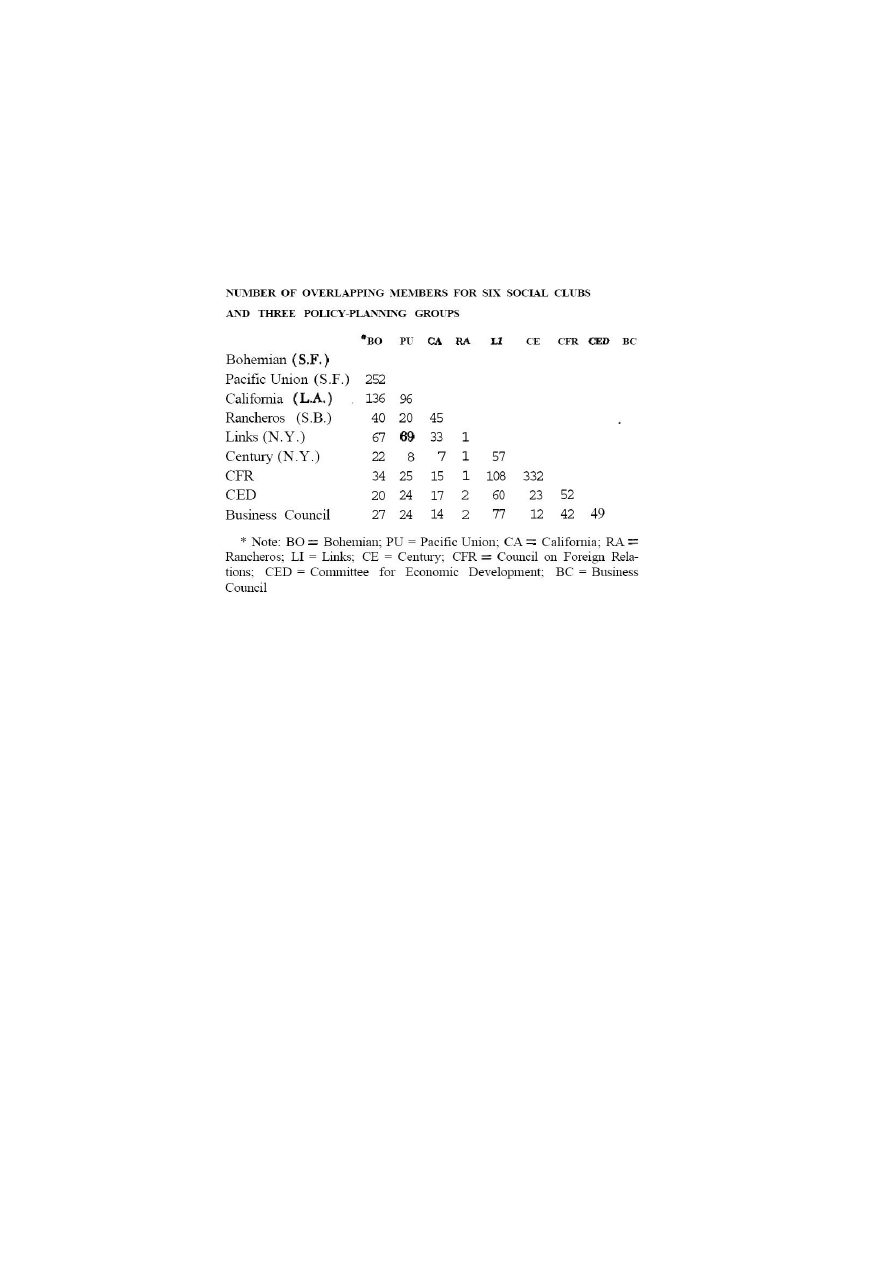
the Bohemian Club, the Pacific Union, and the California Club.
And, not surprisingly, it can be seen that the New York social
clubs have the greatest number of connections to the New
York-based Council on Foreign Relations. More generally, the
analysis suggests that six social clubs and three policy-planning
groups unite the dominant portions of the American business
community into a social and communication network.
It should be emphasized that the interlocking overlappers
presented in the matrix are not a big percentage of the total
club memberships. The degree of overlap ranged from highs of
40 percent (Links Club and Business Council), 29 percent
(Bohemian Club and Pacific Union), 25 percent (Business
Council and Committee for Economic Development), and 23
percent (Century Association and Council on Foreign Rela-
tions) to less than one percent in the cases of the Century
105

Association with the Pacific Union, the Century Association
with the California Club, and the Rancheros with the Links,
the Century, the Council on Foreign Relations, and the Com-
mittee for Economic Development.
29
But the interlocking members, however small their per-
centage of the total membership, are among the most prominent
leaders in the ruling class. They are the people who span many
interests and organizations, involving themselves in social,
economic, and political decisions of major consequence in a
variety of issue areas. For instance, the three men in the table
with six interlocks apiece—Stephen D. Bechtel, John McCone,
and Otto N. Miller—are among the most influential men in the
western United States. Bechtel, the chairman of the family-held
Bechtel Construction Corporation, is one of the five or ten
richest men in the country. He is also a director of Morgan
Guaranty Trust, Southern Pacific, Industrial Indemnity Cor-
poration, California Shipbuilding Corporation, and Stanford
Research Institute.
30
McCone, who was director of the CIA
during the Kennedy administration, joins Bechtel as one of the
nation's wealthiest men, and sits on such boards as United
California Bank, Western Bancocorporation, Pacific Mutual
Life, Standard Oil of California, and ITT. And Miller is the
president of Standard Oil of California, the thirteenth largest
industrial corporation in the United States as of 1969.
Thirteen men had five connections within the nine organiza-
tions studied. They include multimillionaires from New York,
29. These percentages of overlap were obtained in each case by divid-
ing the number of common memberships in a pair by the total number
of members in the smaller of the two organizations in the given pair.
30. See Burton H. Wolfe, "Bay Area Rapid Transit-. Steve Bechtel's
$2 Billion Toy" (San Francisco Bay Guardian, Feb. 14, 1973), p. 1, for a
detailed journalistic account of the Bechtel family and its influence.
106

Ohio, Texas, and California, as well as the chiefs of such giant
companies as Bank of America, Southern Pacific, General Elec-
tric, and Time Inc. Another 53 men had four interconnections.
This group includes—in addition to multimillionaires and cor-
porate heads—four top-level corporation lawyers from New
York, Los Angeles, and San Francisco, and two university ad-
ministrators. Generally speaking, the 1,070 men who constitute
the entire matrix of interconnections were a cross-section of
the country's major decision makers and their academic ad-
visers between the years 1965 and 1970.
The network presented in this section is merely a glimpse
into the cohesiveness of the American ruling class. The com-
plete picture, which would include family connections, school
cliques, attendance at summer and winter resorts, and corpo-
rate boards, as well as many more clubs and policy groups,
defies easy analysis. It awaits a large-scale study utilizing com-
puter capabilities. However, the enormous complexity of ruling-
class networks can be grasped by a brief look at the hundreds
of connections maintained by the members of just one organiza-
tion we have studied—the Business Council.
For this particular analysis we tabulated all the links revealed
by the 154 Business Council members who were listed in Who's
Who in America for 1971-72. Our study of this information,
which is not always complete information because it is self-
reported, showed that these 154 men held 730 directorships in
435 banks and corporations. In addition, they had 49 foundation
trusteeships in 36 different foundations, and 125 trusteeships
with 84 universities. Further, they were members of dozens of
major social clubs encompassing every region of the country.
The 435 corporations represented at the Business Council were
at the heart of the big-business community. One hundred
107
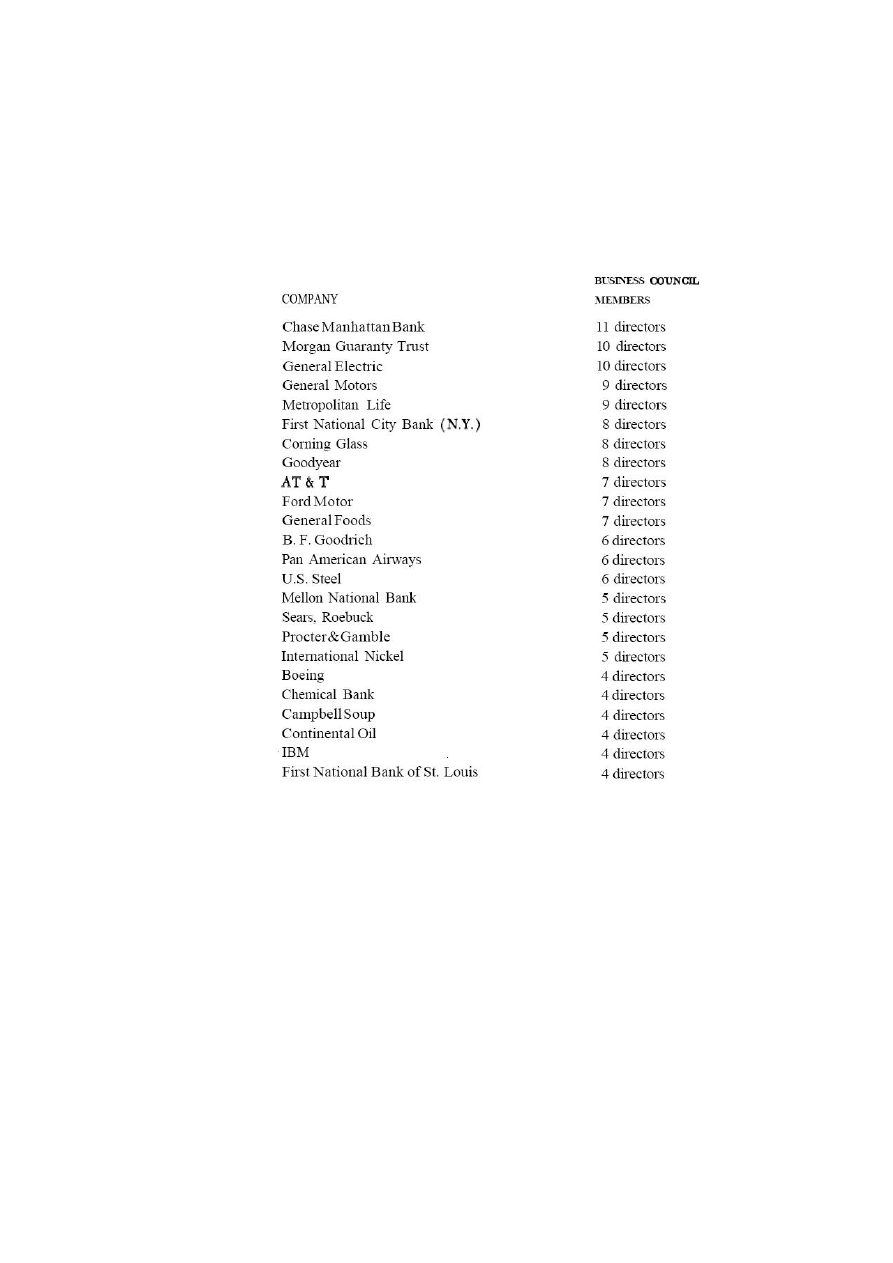
seventy-six of them were among the 797 largest corporations,
with many of those 176 coming from the top 25 for industrials,
rails, banking, and insurance. The companies most heavily rep-
resented in terms of directors at the Business Council tete-a-
tetes with government were the following:
108

Eli Lilly
Mutual of New York
New York Life
Southern Pacific
Standard Oil of New Jersey
4 directors
4 directors
4 directors
4 directors
4 directors
In summarizing this section, I would contend that the infor-
mation presented on the overlapping memberships among six
social clubs and three policy-planning groups is good evidence
for the cohesiveness of the American ruling class. I also would
emphasize that the Bohemian Grove, with its many delights,
and the Business Council, with its many governmental contacts,
are two central points in a network of ruling-class institutions
which embraces social interaction, business communication,
and policy formation.
Conclusion
I began this chapter by expressing the fond hope that by the
end of it there would be no doubt in anyone's mind as to the
existence of a ruling social class in the United States, a ruling
class made up of owners and managers of large banks and cor-
porations. After defining what is meant by a social class, I
argued that previous studies of prep-school attendance, sum-
mer resorts, and corporate interlocks, along with the new in-
formation presented herein on Bohemians, Rancheros, and
Roundup Riders, are persuasive evidence for the existence of
a socially cohesive national upper class. I then demonstrated
that this social upper class has developed policy-planning or-
ganizations that concern themselves with developing solutions
to problems of concern to the corporate rich. Finally, I tried to
show the several means by which the plans and opinions of the
109

leaders within these policy-planning groups are communicated
to government. All in all, I think it makes a very good case for
the hypothesis that the social upper class is a ruling class,
especially in light of the amazingly disproportionate amount
of wealth and income controlled by that small group of families.
But, alas, pluralists probably will not be satisfied. To their
way of thinking, "power" can be demonstrated only by studying
the individuals who initiate, modify, and veto specific policy
proposals. They insist that we must trace a variety of issues
from start to finish in order to establish our argument. They do
not believe that power can be inferred from such indicators as
wealth and income statistics, and from the kind of sociological
evidence about the institutional framework of policy formation
which I have presented in brief outline in this chapter.
The pluralists' single-minded way of studying power has a
long and honorable history in American social science. Its roots
are deeply imbedded in certain streams of philosophical think-
ing which try to tell us how science must be done. Empirical
studies such as this book represents have little or no bearing on
the arguments of this tradition. Until pluralists are able to aban-
don cherished assumptions which restrict the kinds of evidence
they find permissible, or until power-structure researchers are
able to complete a wide range of detailed case studies that show
businessmen, lawyers, and employees from the Business Coun-
cil, the Council on Foreign Relations, and the Committee for
Economic Development in the naked act of making decisions,
the argument about the distribution of power in modern Amer-
ica will remain stalemated.
In the meantime, however, let us agree that the rich live very
well indeed even if we can't demonstrate to the pluralists' satis-
faction that they are a "ruling class." After all, with their lavish
110

Cremations of Care, their own private musical comedies, and
their exclusive retreats, to mention only a few of their midsum-
mer pleasures, they probably live just about as well as they
could hope for if they were to be duly certified as an authentic
ruling class:
"Great Owl of Bohemia, we thank
thee for thy adjuration.
Well should we know our living flame
Of Fellowship can sear
The grasping claws of Care,
Throttle his impious screams
And send his cowering carcass
From this Grove.
Begone, detested Care, begone!
. . . Once again Midsummer sets
us free!"
111

Index
Alioto, Joseph, 42
Americans for Democratic Action, 83
Amerine, Maynard A., 46
Amory, Cleveland, 86
Armour, Lolita, 60
Armstrong, Neil, 15, 18
Autry, Gene, 66
Awl, Elmer, 62
Baer, Francis S., 35
Bailard, Willis R., 76
Baker, William G., Jr., 73
Baltzell, E. Digby, 83-84
Bechtel, Stephen D., 35, 106
Bechtel, Stephen D., Jr., 36
Bergen, Edgar, 14, 33, 66, 76
Berle, Milton, 14
Betts, F. Burr, 89
Bierce, Ambrose, 53
Bilderbergers, 93-94
Birmingham, Stephen, 87
Black, James B., Jr., 36
Boeschenstein, Harold, 103
Bogert, Frank M., 65
Bohemian Club, 43-59, 90, 92, 104-
105, 113
Bohemian Grove, 1-59, 88, 102-103,
109
Bolger, Roy, 14, 57
Bolton, Earl C., 18
Bone, Alfred, Jr., 76
Borein, Ed, 67
Borge, Victor, 14
Bosqui, Edward, 54
Bowles, Hargrove, Jr., 72
Brandi, Frederic H., 36, 41
Brandi, James H., 41
Braun, Wernher von, 16
Brown, Fred, 80
Brown, Les, 14
Brown, Pat, 16
Browne, Paul M., 76
Business Council, 93, 98-105, 109-
110
Caen, Herb, 26
California Club, 32, 104-106, 113
Campbell, W. Glenn, 40
Carnegie Corporation of New York, 95
Century Association, 104-106, 113
Century Club, 33
Chambers, Frank G., 76
Chicago Social Register, 30
Clack, W. Turner, 76
Clare, Ada, 53
Clark, William P., Jr., 73
Clay, Lucius, 16, 36
Cochran, Dwight M., 36
Cole, Edward, 18
Commerce, Department of, 99
113

Committee for Economic Develop-
ment, 93, 95-99, 102-106, 110, 113
Common Cause, 83
Coney, Joseph J., 76
Converse, Roger A., 76
Cooley, R. P., 36
Council on Foreign Relations, 93, 94,
95-98, 102-106, 110
Courtright, Hernando, 76
Crocker, William, 58
Crosby, Bing, 14, 33, 57
Crossley, Randolph A., 72, 76
Dahl, Robert A., 85
Dart, Justin, 74, 76
Day, Dennis, 14
De Yong, Joe, 67
Dekker, Joe H., 74, 78-79
Desert Caballeros, 81
Detroit Club, 32, 104
Devine, Andy, 14
Disney, Walt, 67
Ditz, George A., 76
Dixon, Paul Rand, 41
Doan, Leland I., 51
DuBridge, Lee A., 16, 34
Ducommon, Charles, 36-37
Edwards, Ralph, 14
Ehrlichman, John D., 41, 42
Eisenhower, Dwight David, 15
Elite Directory, 54
Federal Deposit Insurance Corpora-
tion, 97
Firestone, Leonard K., 37, 41
Firfires, Nicholas S., 67
Flanigan, John, 37, 76
Flanigan, Peter M., 42
Ford, Henry, II, 52
Ford, Tennessee Ernie, 33
Ford Foundation, 95
Foreign Affairs, 95
Forsythe, Clyde, 67
Freeman, Gaylord A., 41
Frye, Thomas, 80
Gable, Clark, 66
Garland, John J., 76
Gates, Charles C., 80
Gates, Thomas S., Jr., 42
Gilbert, Carl, 94
Gillette, Edmund S., Jr., 37
Gobel, George, 33
Hackett, Raymond, 14
Hansberger, R. V., 101, 102
Harris, Phil, 14, 66
Harte, Bret, 53
Hartley, Fred L., 42
Hickel, Walter J., 41
Hirt, Al, 14
Hodges, Harold M., 84
Hoover, Herbert, 17, 39, 57, 92
Hoover, Herbert, Jr., 40
Hope, Bob, 66
Horton, Jack K., 37
Hotchkis, Preston, 74, 76
Houghton, Amory, 42
Houston Social Register, 30
Howard, Jack R., 41
Huckins, John V., 76
Humphrey, Gilbert, 37
Hunter, Floyd, 92
Jackson, Charles H., Jr., 76
Jagels, George D., 76
James, Harry, 14
James, Will, 67
Jetton, Martin, 79
Johansen, Gunnar, 18
Johnson, Frank Tenney, 67
Johnson, Lyndon B., 99
Jones, Hardin B., 18
Justin, John, 72
Kahl, Joseph A., 86
Kaiser, Edgar F., 37
Kaiser, Edgar F., Jr., 41, 51
Kavaler, Lucy, 87
Kayser, Kay, 66
Kennedy, David M., 41, 42
Kennedy, Robert F., 15
King, John M., 80
King's Men, The, 66
Kirk, Grayson, 34
Kissinger, Henry, 18, 98
Knight, Goodwin J., 16
Laird, Melvin, 18, 42
Lane, Lawrence W. Jr., 74, 76
114

Lane, Melvin B., 74, 76
Lapham, Lewis, 38
Lawrence, Ernest O., 58-59
Le Vesconte, Ed, 77
Linkletter, Art, 14, 57, 66, 77
Links Club, 104-106
Littlefield, Edmund, 38
London, Jack, 53, 57
Los Angeles Blue Book, 30
Lundborg, Louis, 41
McCollum, Leonard F., 38
McCone, John A., 38, 106
McCormick, Brooks, 72
McDuffie, Malcolm, 77
McEwen, Owen C., 81
McLean, John G., 42
MacMurray, Fred, 78
Manning, Bayless, 34
Martin, Dick, 33
Marring, Walter A., 42
Mathias, Bob, 73
Maynard, Ken, 66
Merrill, John L., 77
Milbank, Jeremiah, 40
Miller, Otto N., 106
Mitchell, John J., 60-62, 71, 74, 77,
88-89
Monson, Arch, Jr., 77
Montana, Montie, 65, 78, 79
Montgomery, George C., 38
Moorer, Thomas H., 41
Morgan, Charles F., 41
Morgan, Dennis, 78
Morgan, Henry S., 41
Mosbacher, Emil, 18
Murphy, Audie, 78
Murphy, Dwight, 63
Nabors, Jim, 66
National Aeronautics and Space Ad-
ministration, 97
National Association of Manufac-
turers, 83, 94
National Municipal League, 93
Nelder, Alfred, 42
New York Social Register, 30
Neylan, John, 58-59
Niggeman, Louis, 51
Nixon, Richard M., 15-16, 19, 40
Odegaard, Charles E., 34
Ohanneson, John, 77
Olympic Club, 43
O'Melveny, John, 74, 77
O'Neill, Billy, 66
Our Society Blue Book, 54
Pacific Union Club, 30, 32, 43, 54,
104-106, 113
Packard, David, 41
Parry, Albert, 56
Patterson, William A., 41
Patterson, William A., Jr., 41
Pauley, Edwin W., 41, 74, 77
Peake, Channing, 67
Peterkin, DeWitt, Jr., 51
Peterson, Rudolph A., 18, 38, 41
Philadelphia Social Register, 30
Phleger, Atherton, 39
Phleger, Herman, 39
Pitchess, Peter J., 42, 72
Polsby, Nelson, 95
Poor's Register of Corporations, Ex-
ecutives, and Directors, 31, 71, 81
Pope, Henry, Jr., 77
Powell, Reed, 91-92
Powers, Gallatin, 77
President's Blue Ribbon Defense
Panel, 97
Private World of High Society, The
(Kavaler), 87
Proper Bostonians, The (Amory), 86
Pullian, Eugene C., 40
Rancheros Vistadores, 61-74, 88-89,
104-106
Reagan, Ronald, 41, 72, 73
Reed, Philip D., 39, 103
Republican party, 32
Reynolds, Thomas A., Jr., 73
Rickenbacker, Eddie, 40
Ricketson, Frank H., Jr. (Rick), 74-
75, 78, 79, 89
Right People, The (Birmingham), 87
Robertson, Dale, 78
Rockefeller, Nelson, 17, 51-52
Rockefeller Foundation, 95
Rogers, Roy, 66
Rogers, Will, 57
Rogers, William P., 18
Rosen, Carl G. A., 77
11

Roundup Riders of the Rockies, 75,
78-81, 89
Rowan, Dan, 14
Sage, Andrew G. C., 42
San Francisco Blue Book, 54
San Francisco Social Register, 30, 55
Sarnoff, David, 16
Schwegel, Frank, 72
Seaborg, Glenn T., 34
Secret Diary of Harold L. Ickes, The
(Ickes),'l2
Seitz, Frederick, 41
Sesnon, Porter, 74, 77
Sexton, Dorrance, 42-43
Shakespeare, Frank, 18
Shearing, George, 14, 57
Sibley, Shermer L., 39
Skakel, Rushton, 72, 73
Smythe, Pete, 78
Spencer, William M., 77
Sproul, Robert G., 58
State, Department of, 97
Stein, Herb, 98, 102
Sterling, George, 53, 56
Sterling, J. E. Wallace, 40
Stoddard, Charles Warren, 9, 10, 53
Strouse, Norman H., 18
Sweezy, Paul, 85
Symonds, Gardiner, 39
Taft, Robert, 16
Tavern Club, 33
Tavernier, Jules, 55-56, 57
Thomas, Lowell, 14, 40
Thomason, A. Mims, 41
Thompson, Wayne E., 51
Tibbs, Casey, 78
Topping, Norman, 34
Train, Russell E., 18
Twain, Mark, 53
Upchurch, Haden, 73
Van Dyke, Jerry, 14
Verde Vaqueros, 81
Walters, Kenneth W., Jr., 77
Warren, Earl, 16
Weber, Max, 85
Wedemeyer, Albert C., 40
Whalen, Richard J., 15-16
Who Killed Society? (Amory), 86
Who's Who in America, 34, 107
Wiester, John S., 77
Wilde, Frazar B., 93
Wilkinson, Ernest L., 18
Williams, Robley C., 18
Woggon, Bill, 67
Wouk, Herman, 15, 57
Wrigley, Philip K., 72
Wulsin, Lucien, 72
Yates, Burnham, 80
Yorty, Samuel, 42
Younger, Evelle, 72
Zachrisson, Carl, 77
116
Wyszukiwarka
Podobne podstrony:
The Bohemian Grove and Other Retreats A Study in Ruling Class
Domhoff G William, Bohemian Grove and Other Retreats A Study In Ruling Class Cohesiveness (1974)
The?ltics Nationalities and Other Problems
[Mises org]Mises,Ludwig von The Causes of The Economic Crisis And Other Essays Before And Aft
The Listerdale Mystery and Other Stories
The Fairy Godmothers and Other Tales
Fyodor Dostoevsky The Eternal Husband, and Other Stories (Transl Richard Pevear, Larissa Volokhonsk
Oscar Wilde The Happy Prince and Other Tales całość
The Last Ghost and Other Storie Stephen Goldin
Dorothy Cannell The Family Jewels and Other Stories (retail) (pdf)
Fritz Leiber The Mind Spider and Other Stories
Agatha Christie Poirot 27 The Under Dog And Other Stories
The Astral Body and Other Astral Phenomena by Arthur E Powell
Fritz Leiber The Black Gondolier and Other Stories
Edmund Leamy The Golden Spears and Other Fairy Tales (Ill Corinne Turner)
Edgar Allan Poe The Murders In the Rue Morgue and Other Stories
The Devil s Pool and other stories
PENGUIN READERS Level 4 The Doll s House and other stories
The Microcosmic God and Other S Sam Moskowitz
więcej podobnych podstron